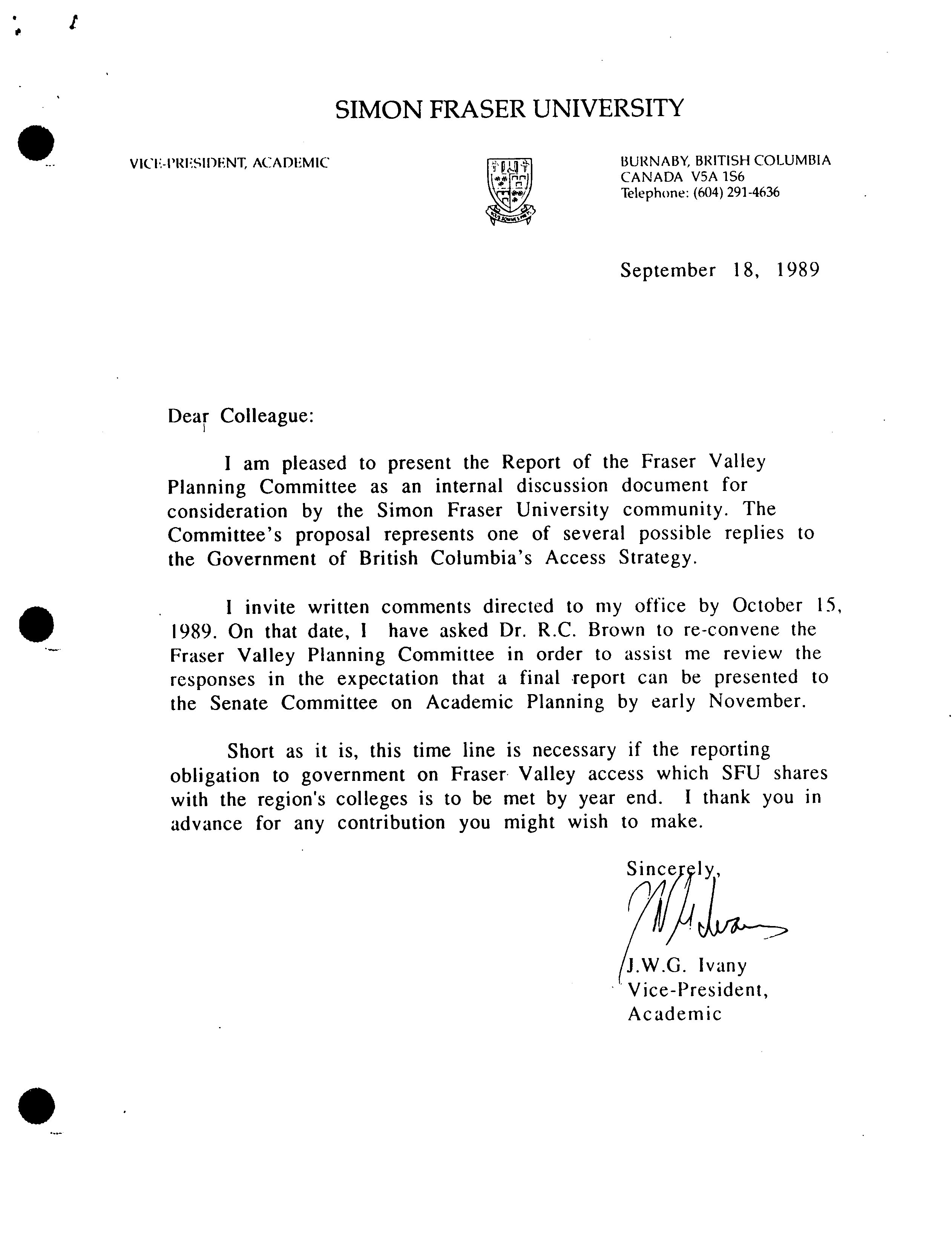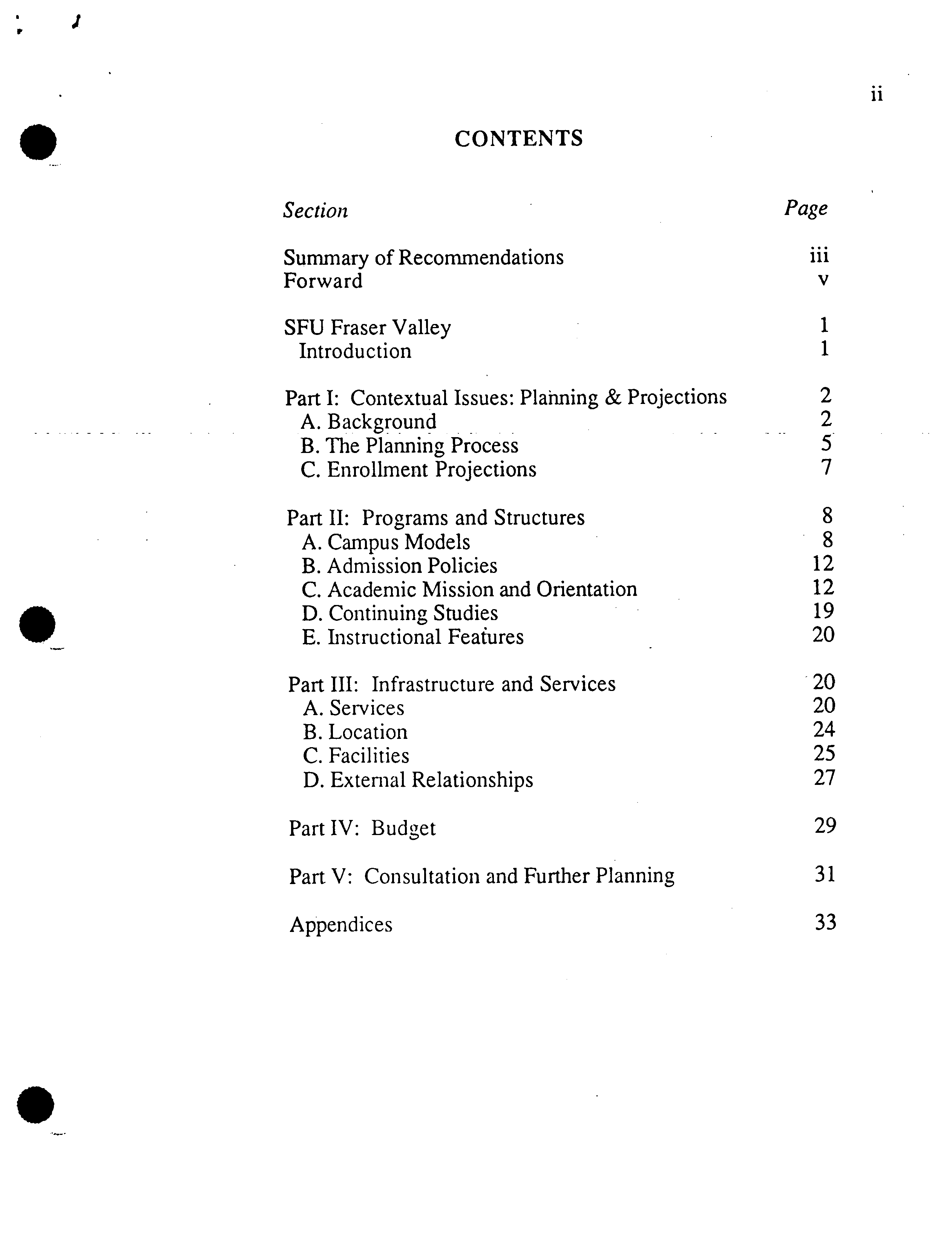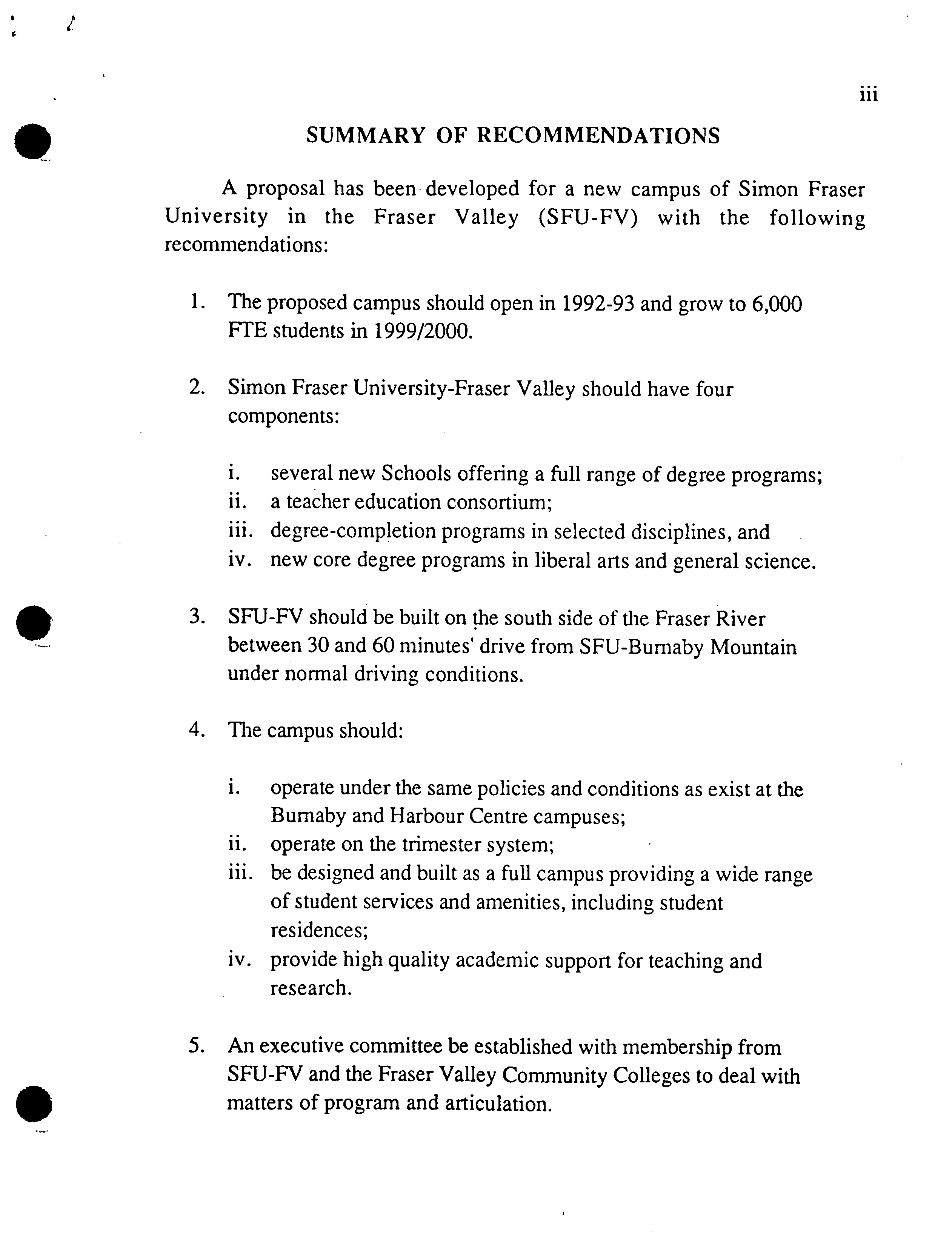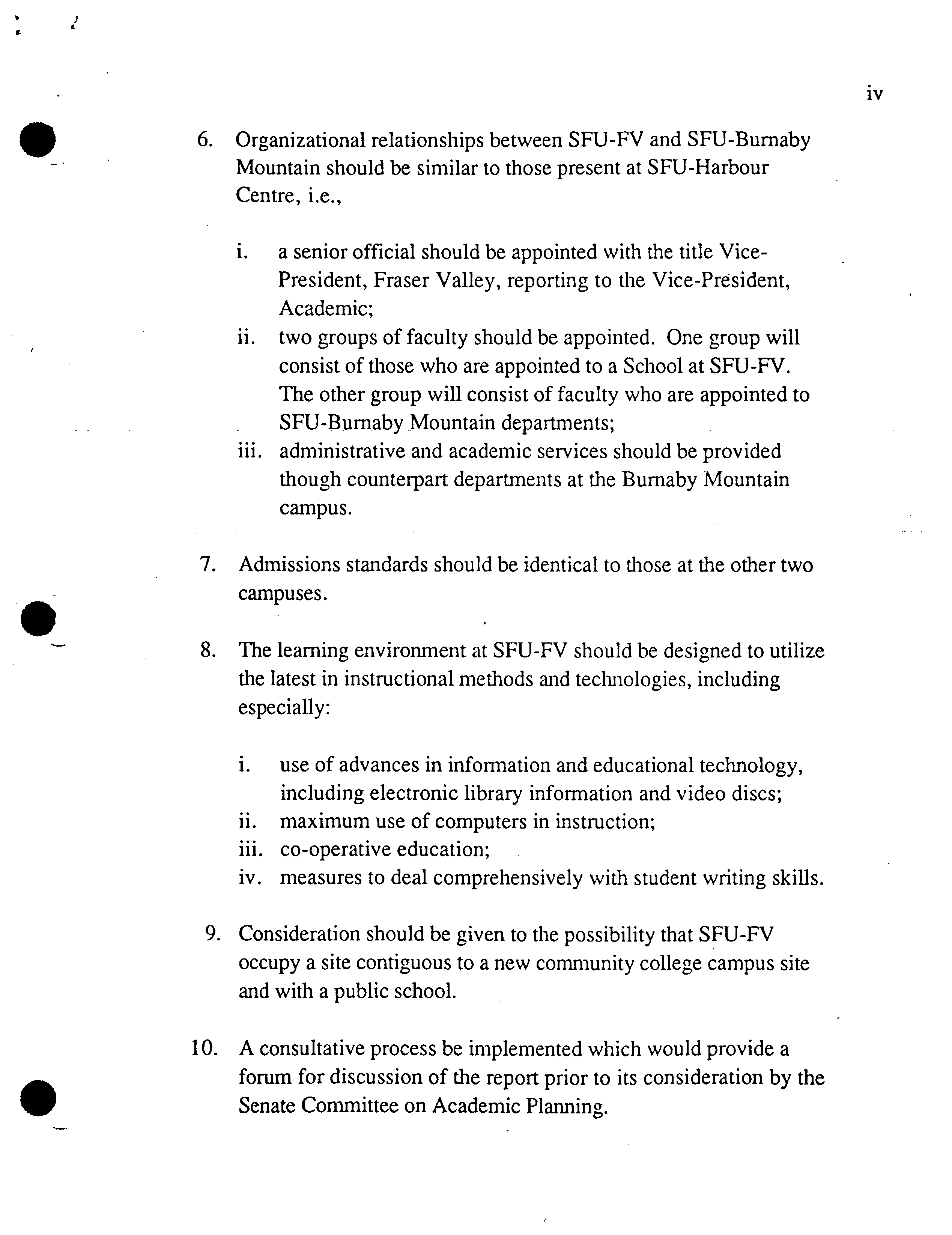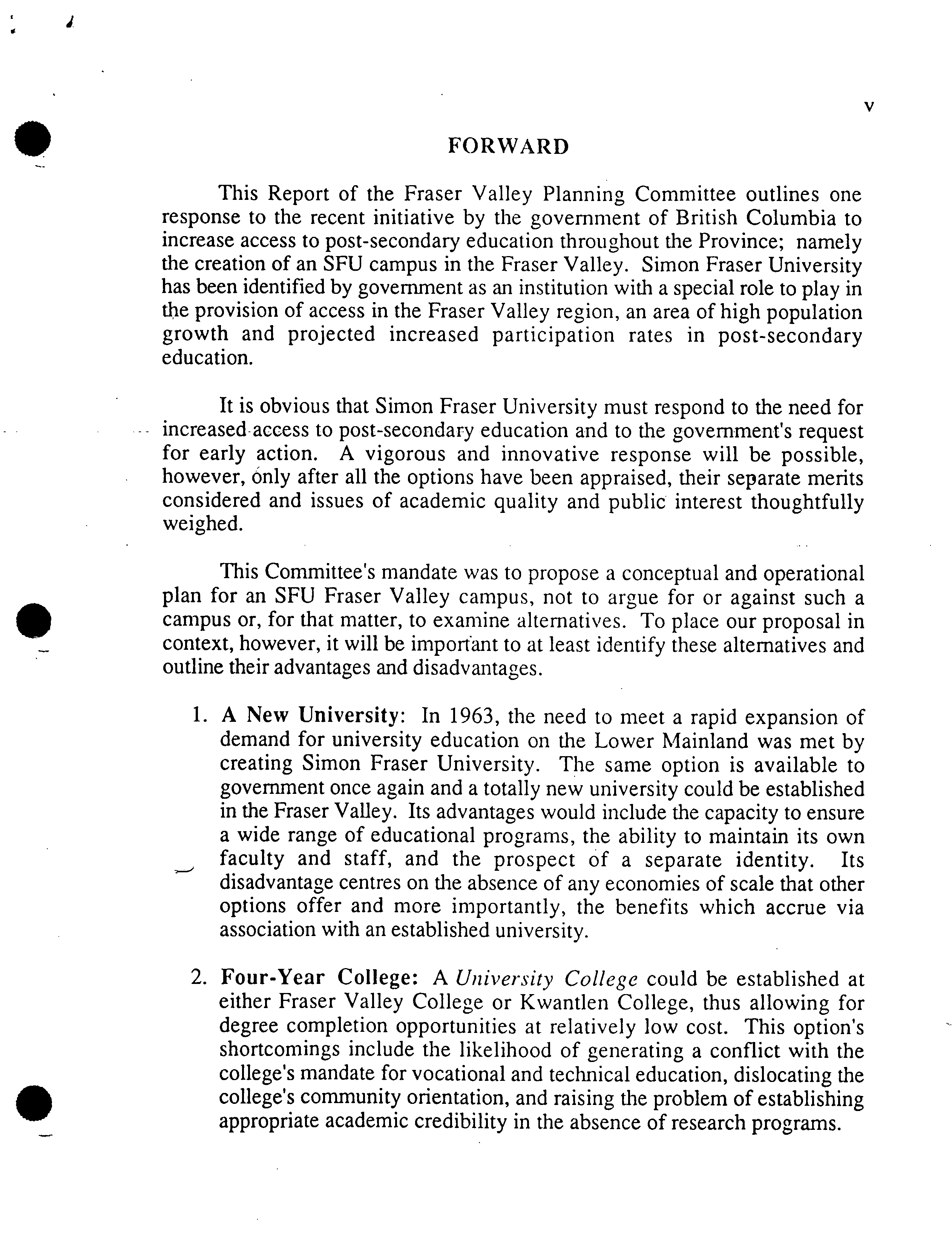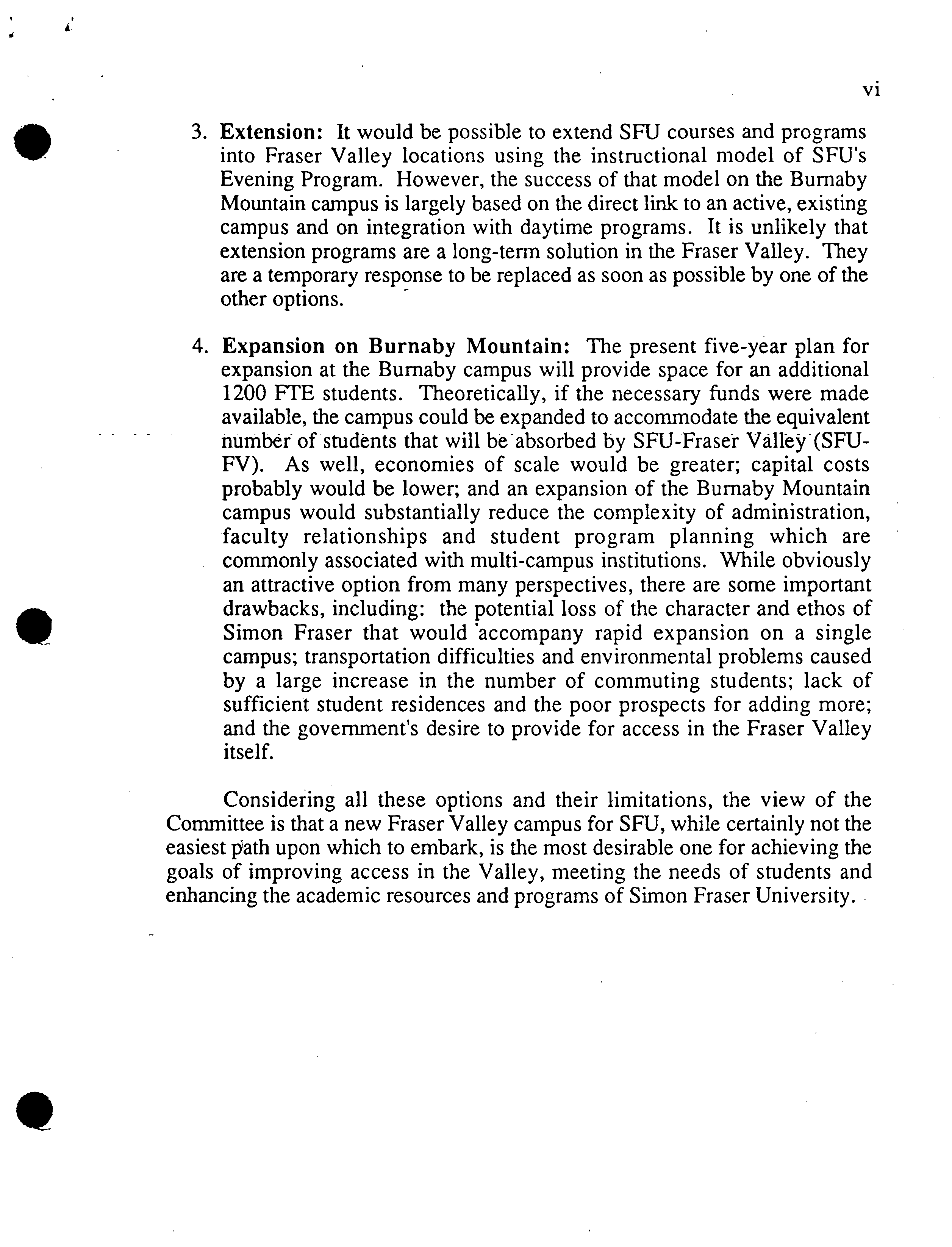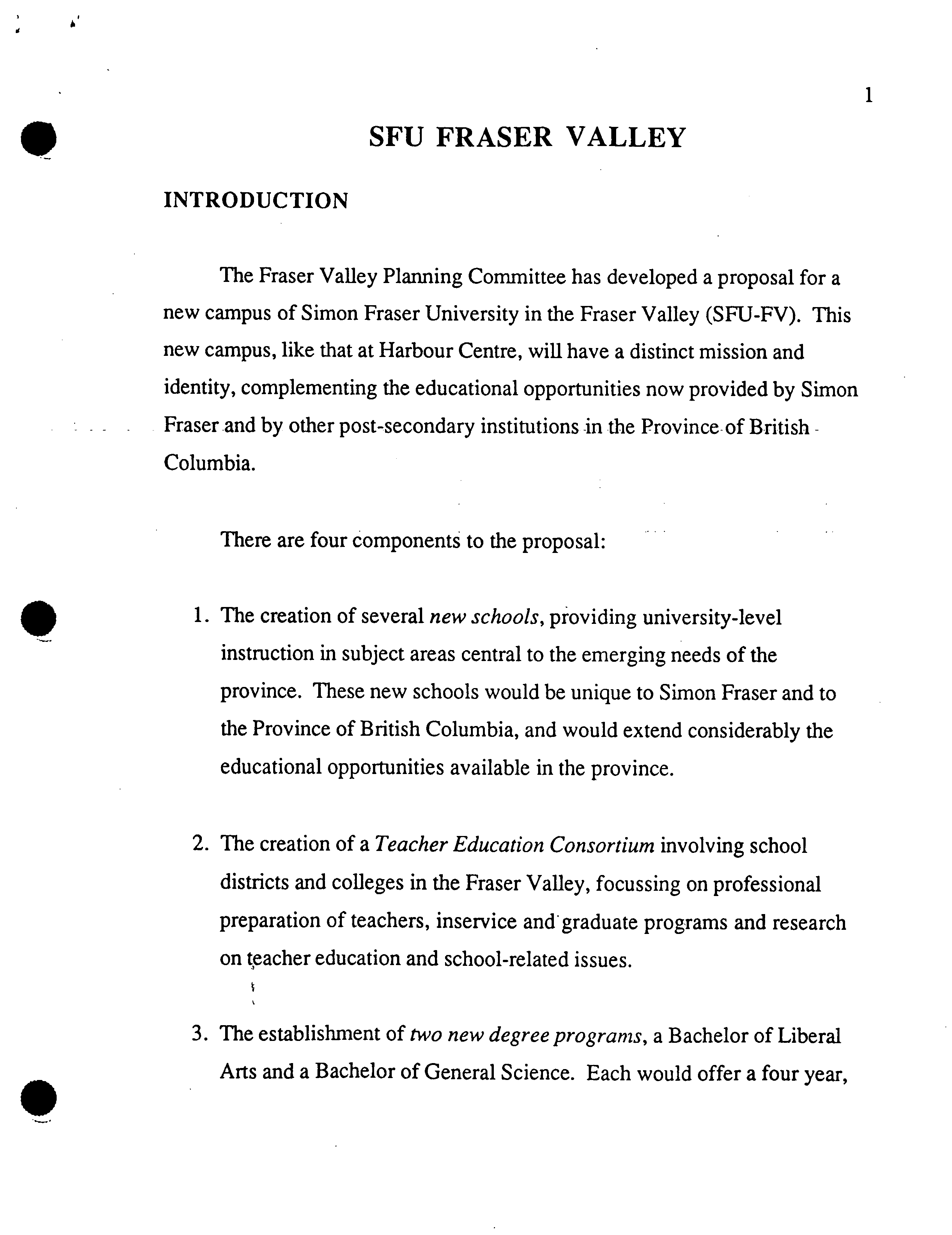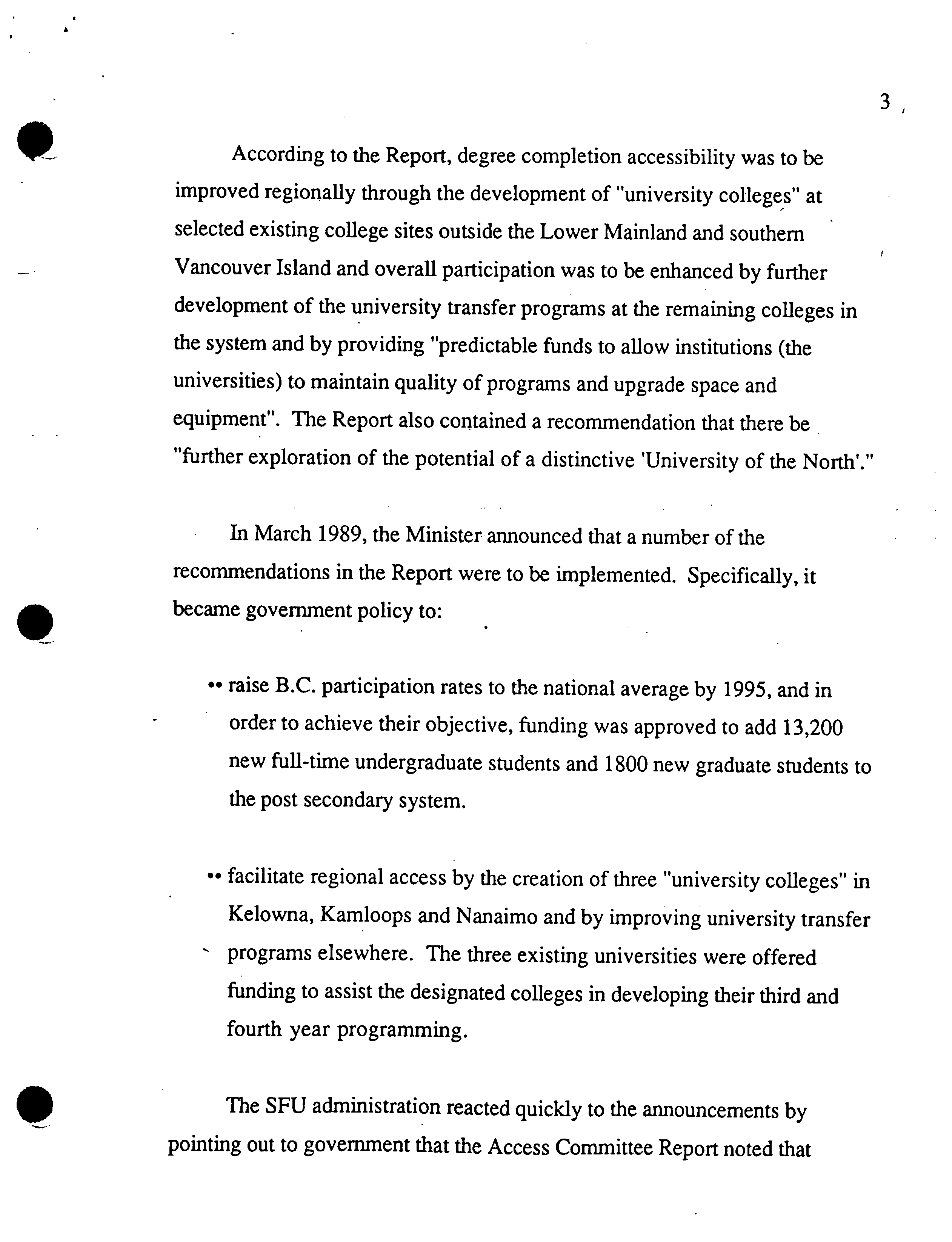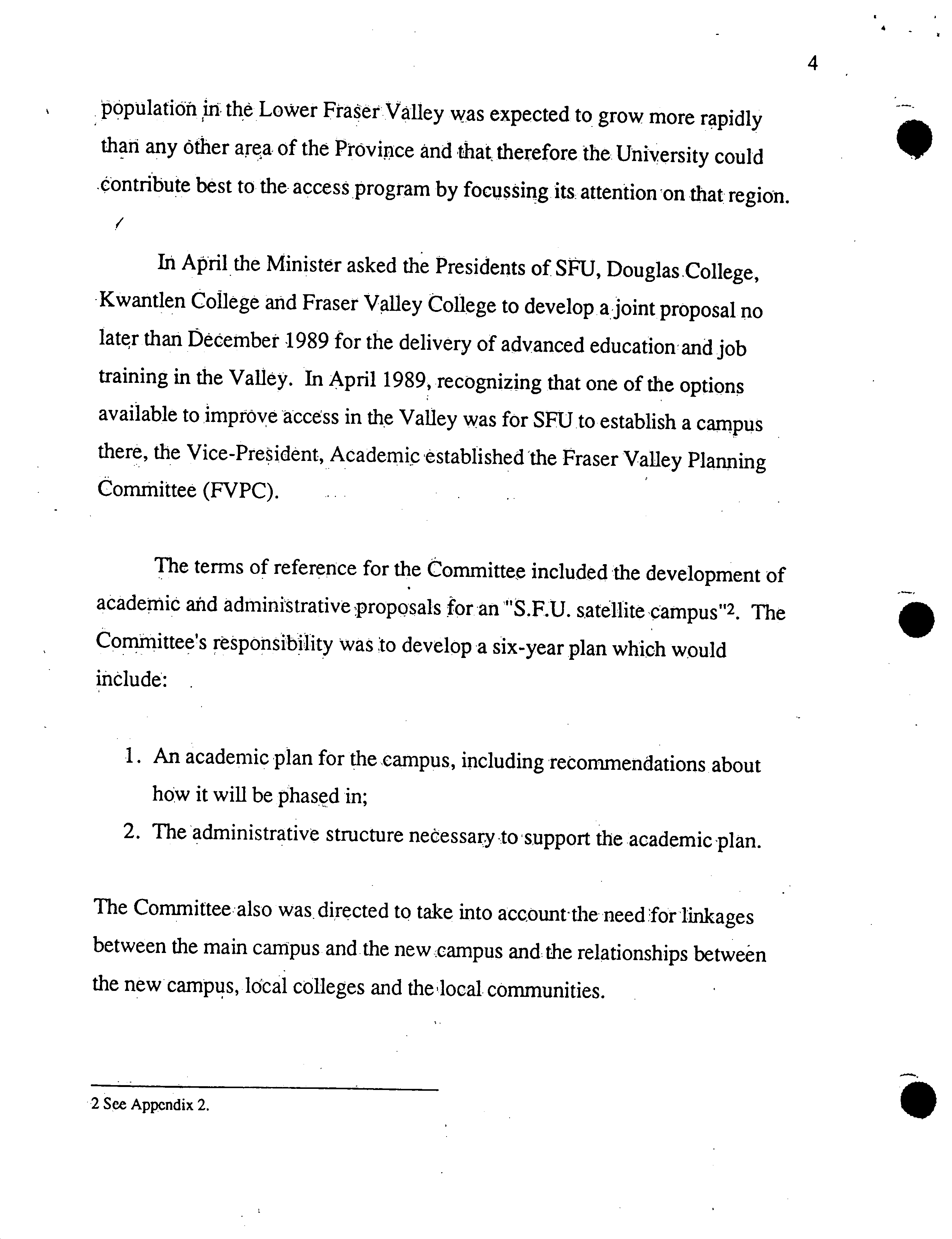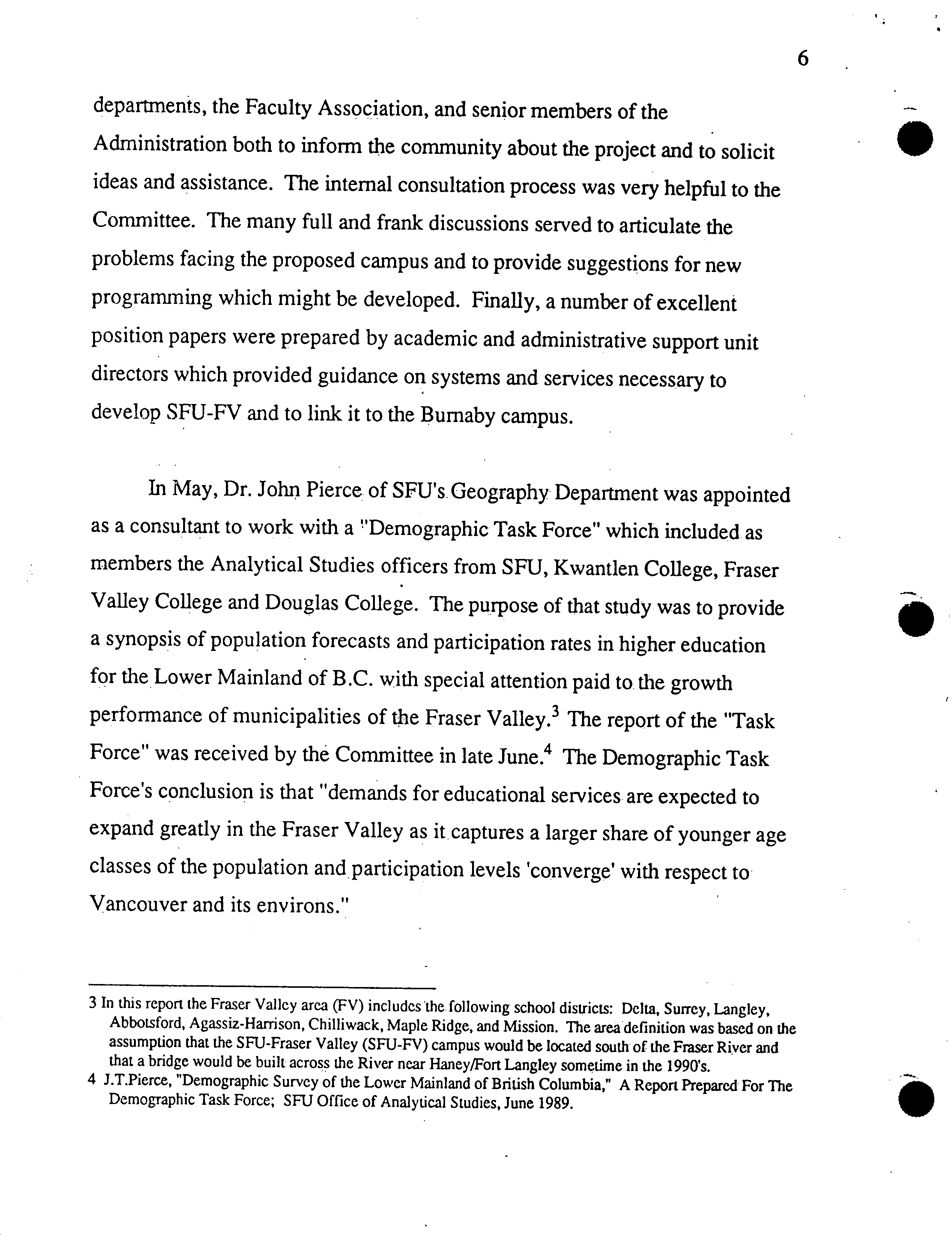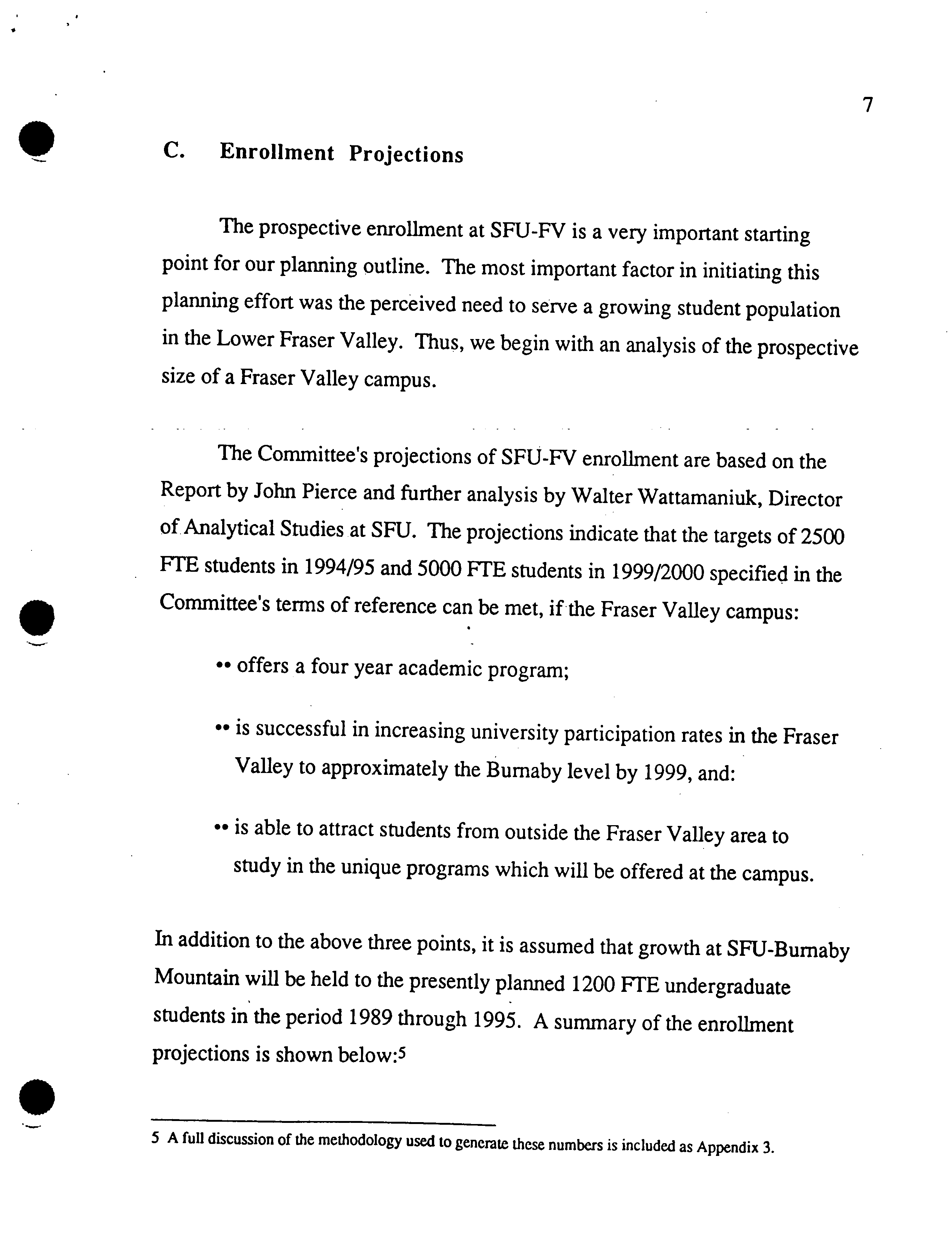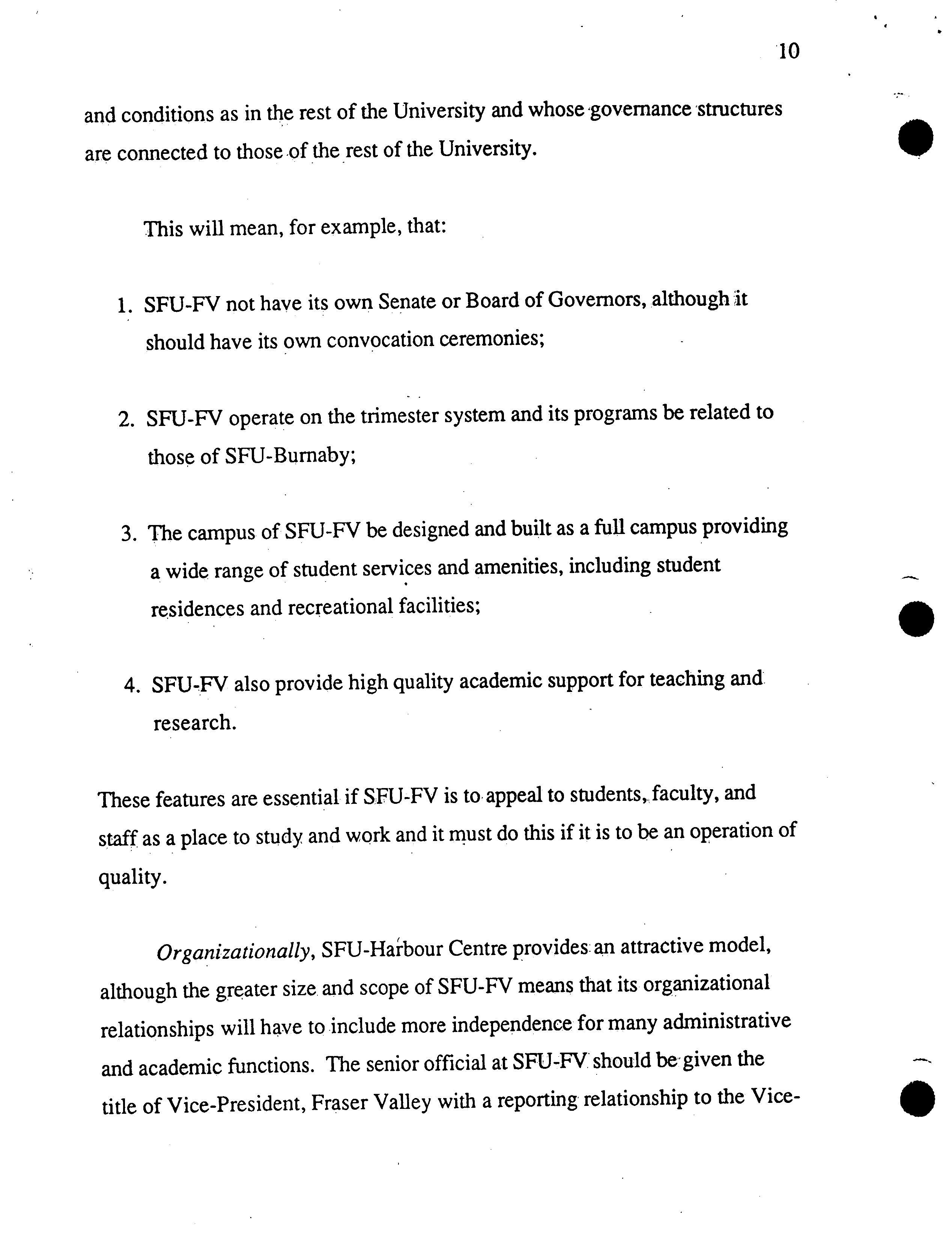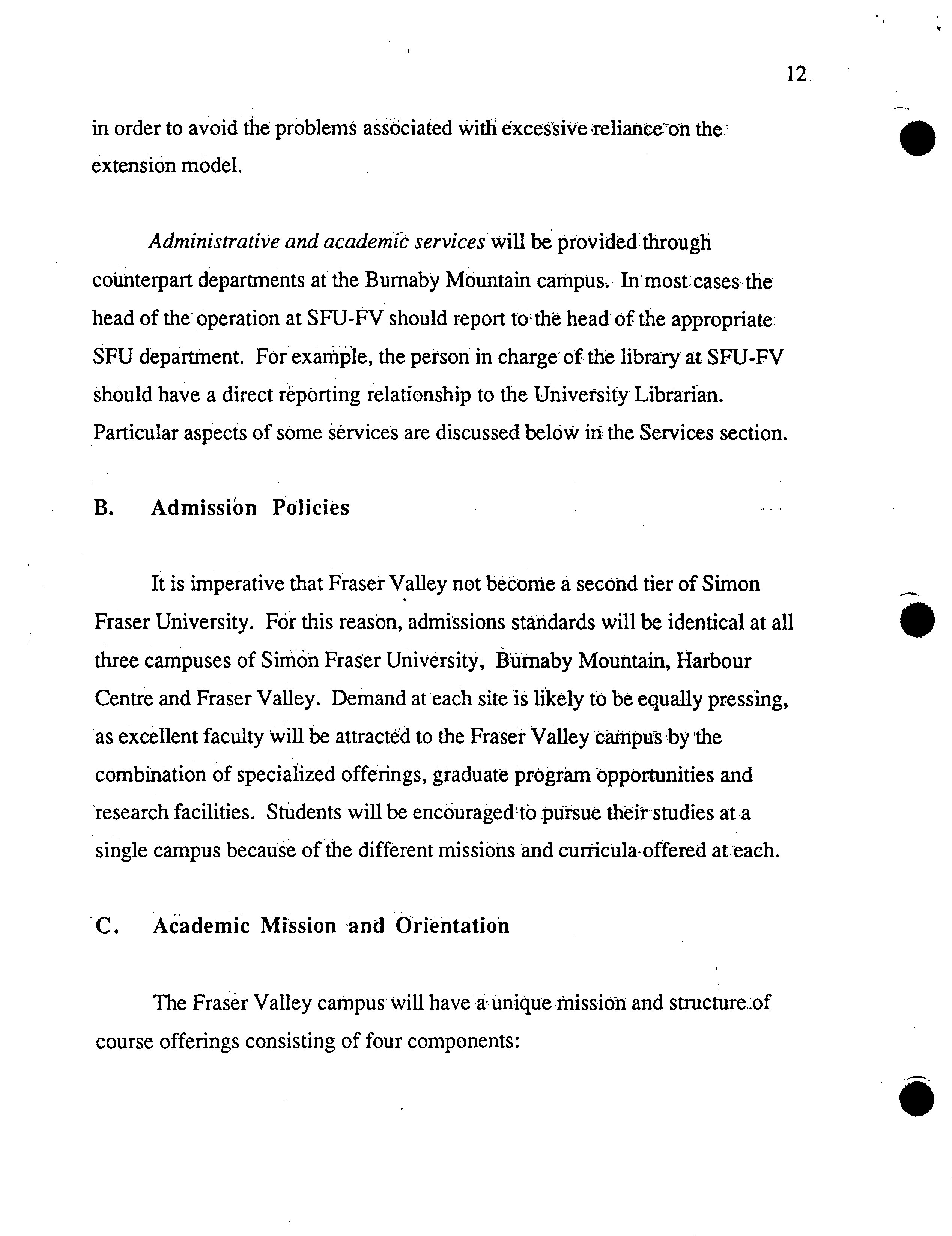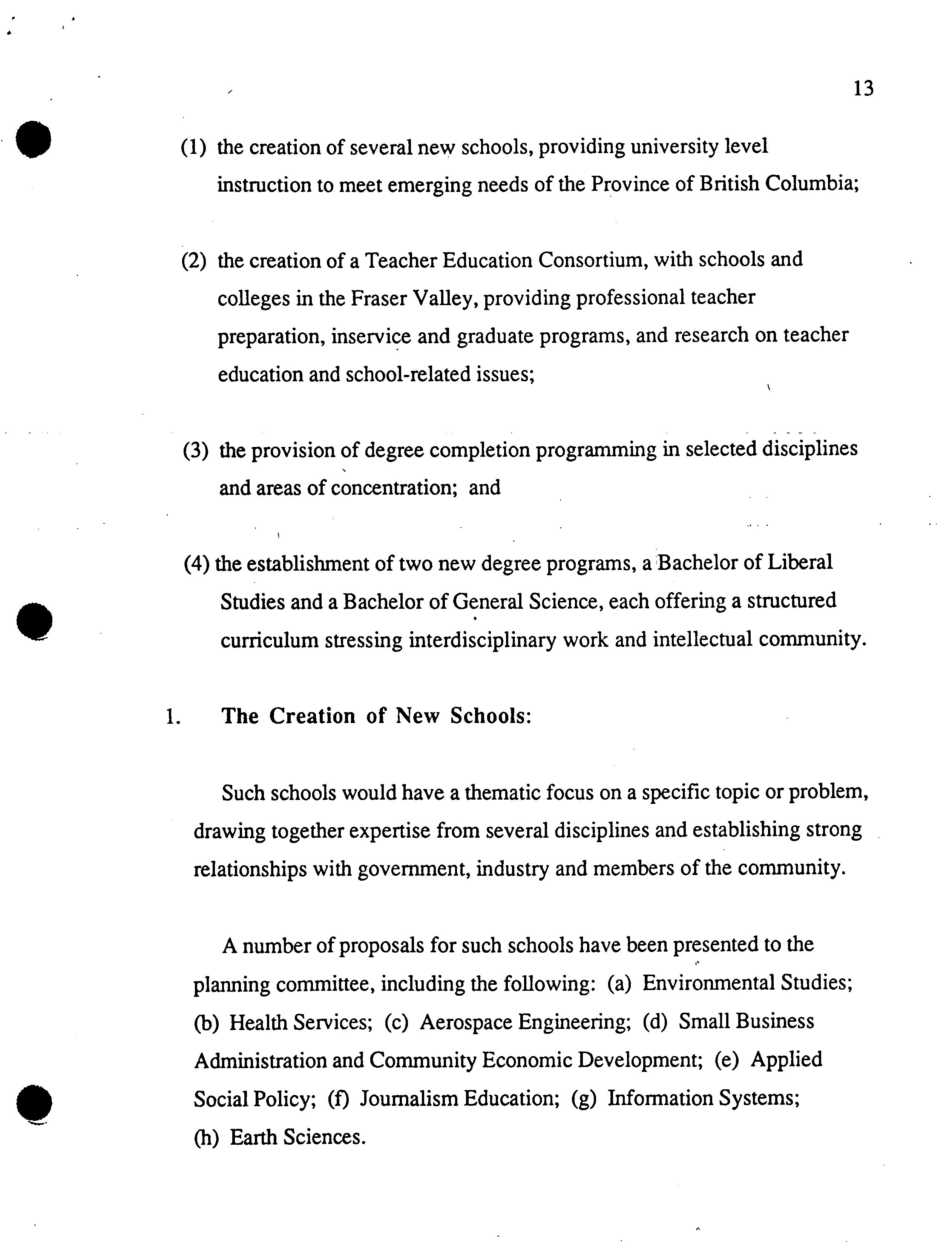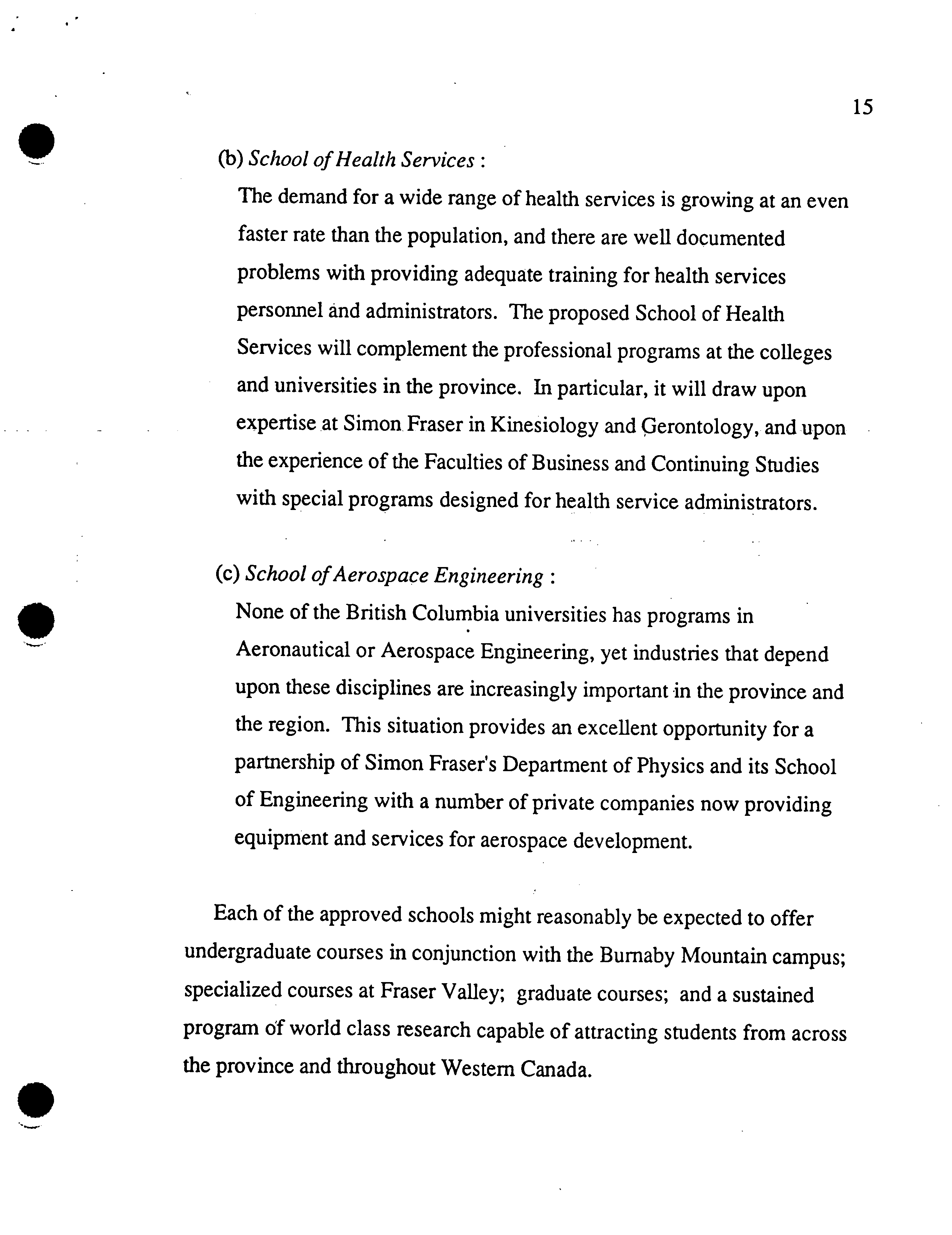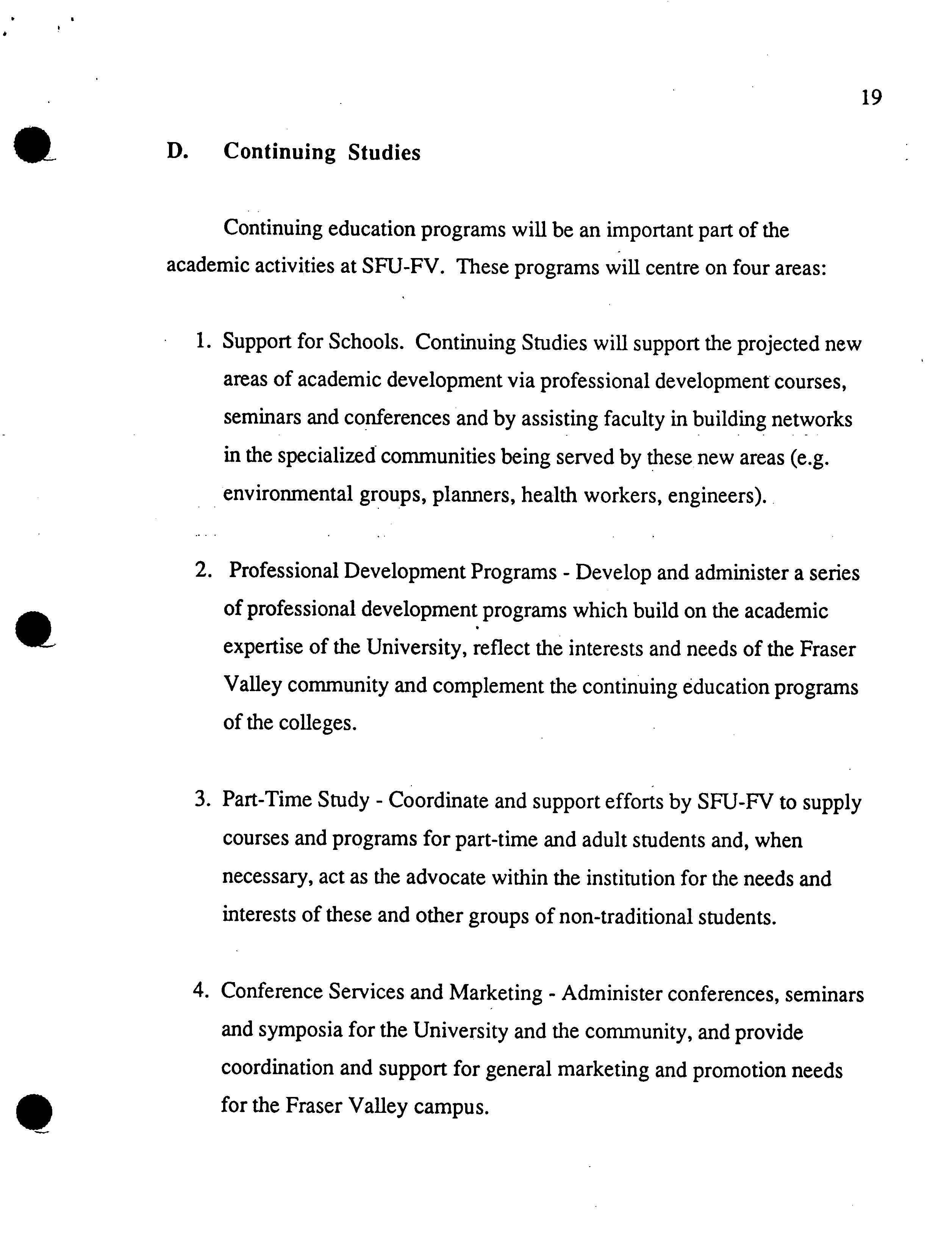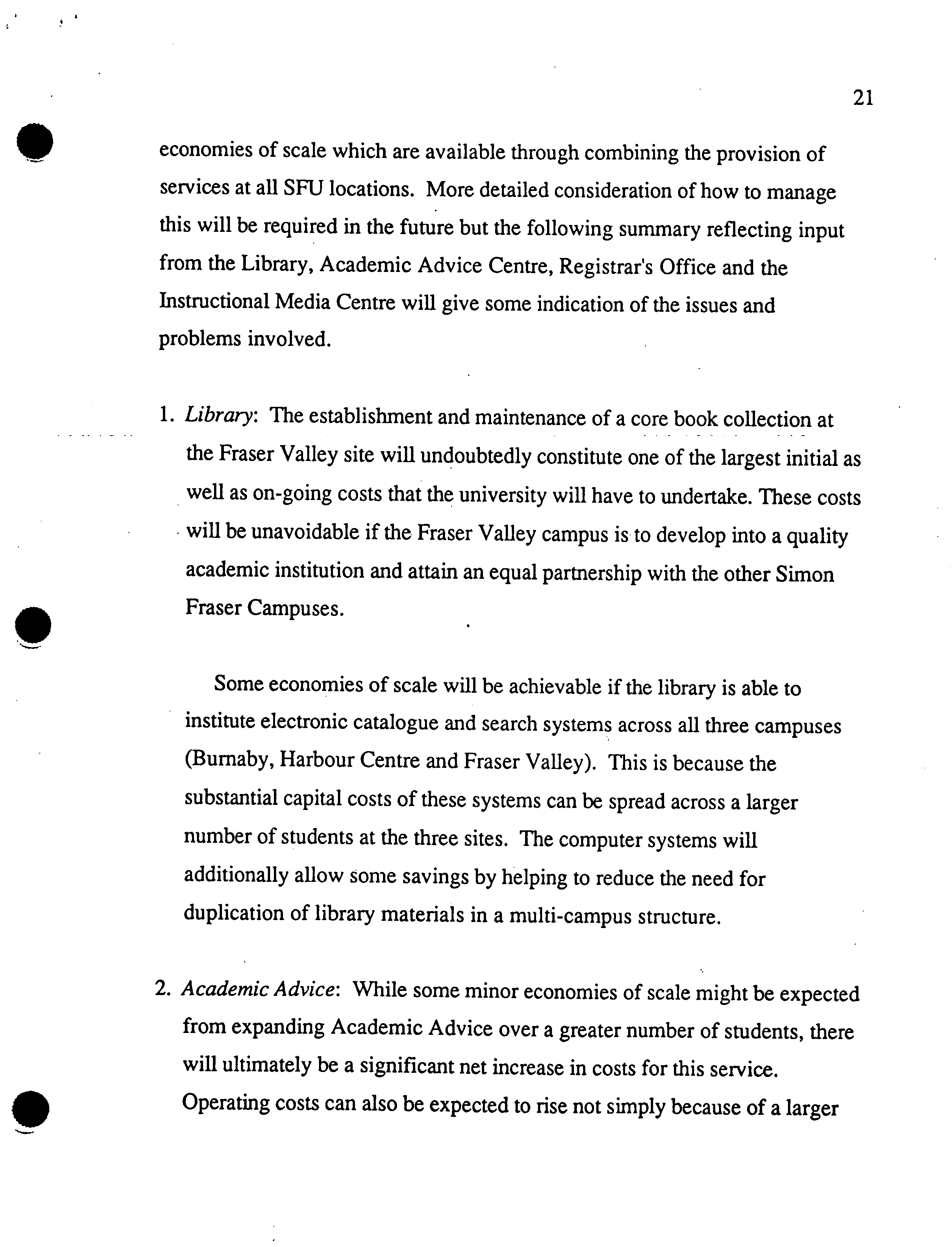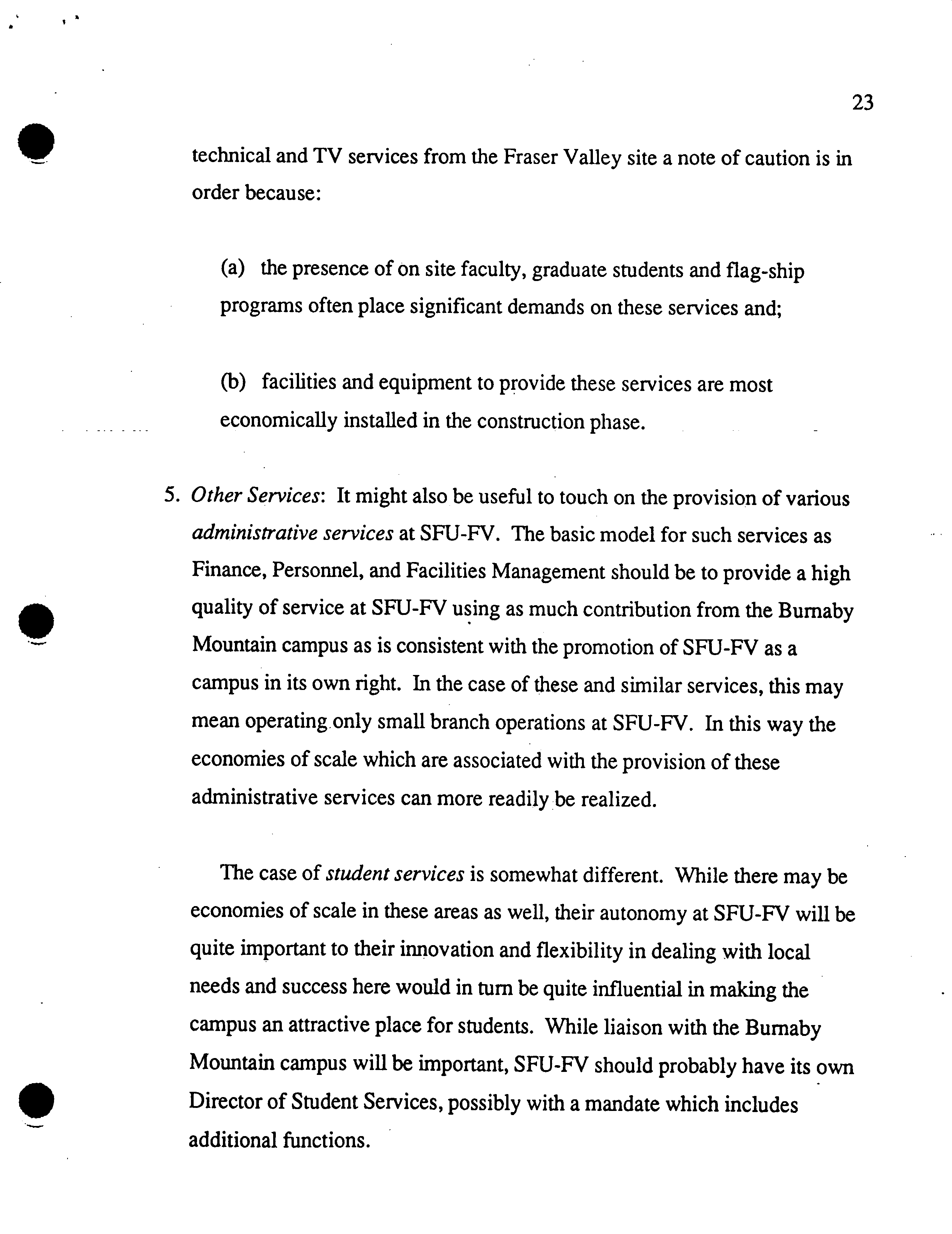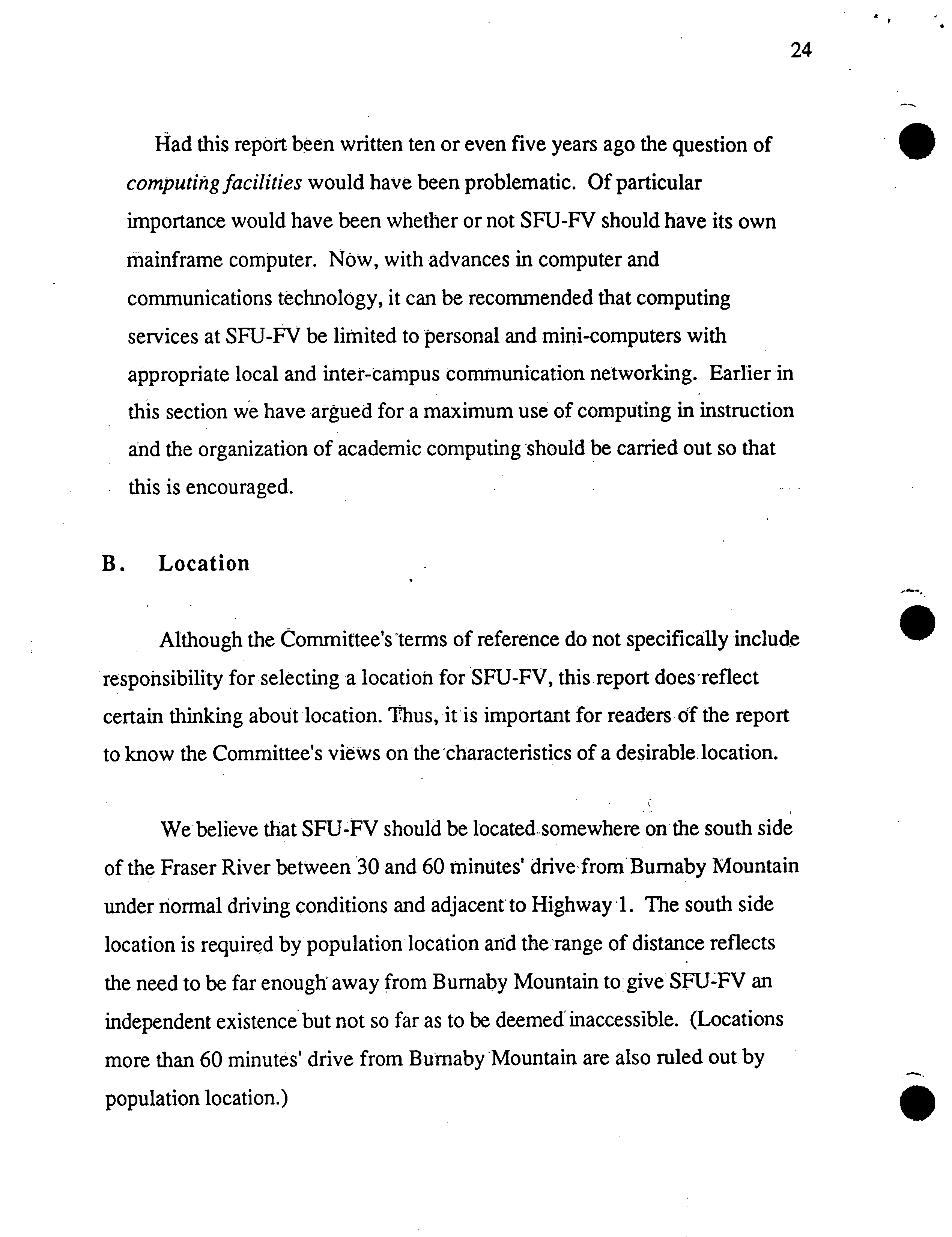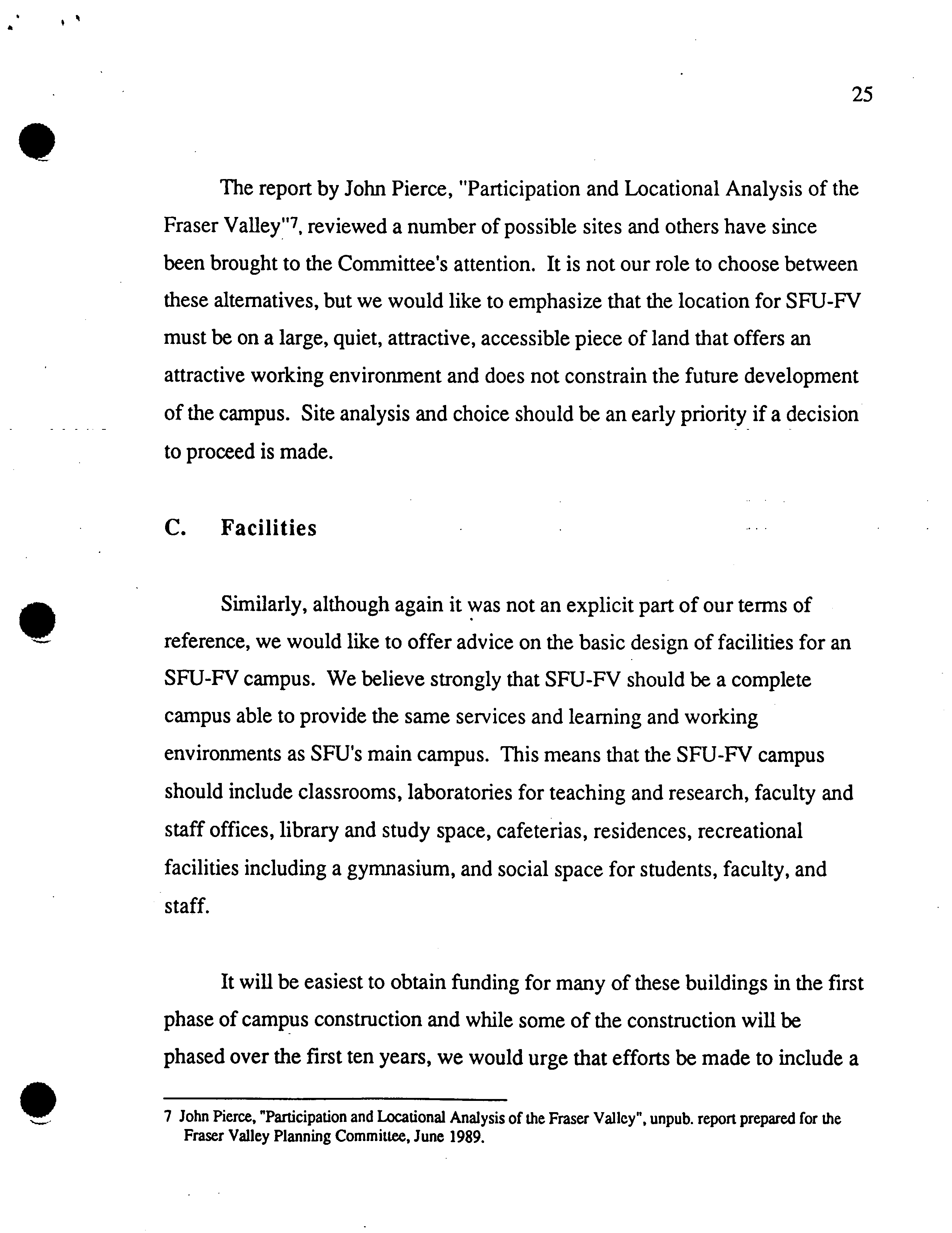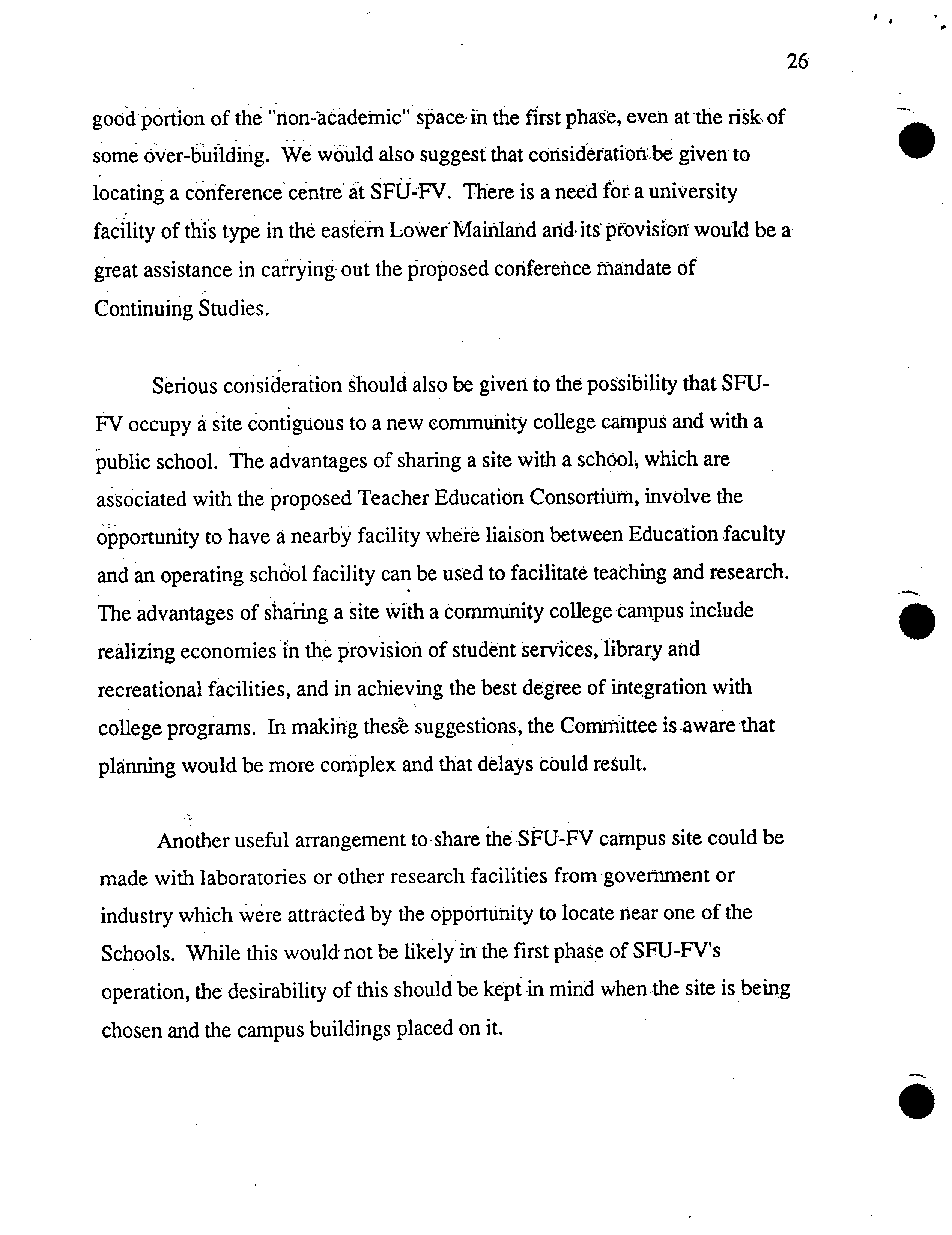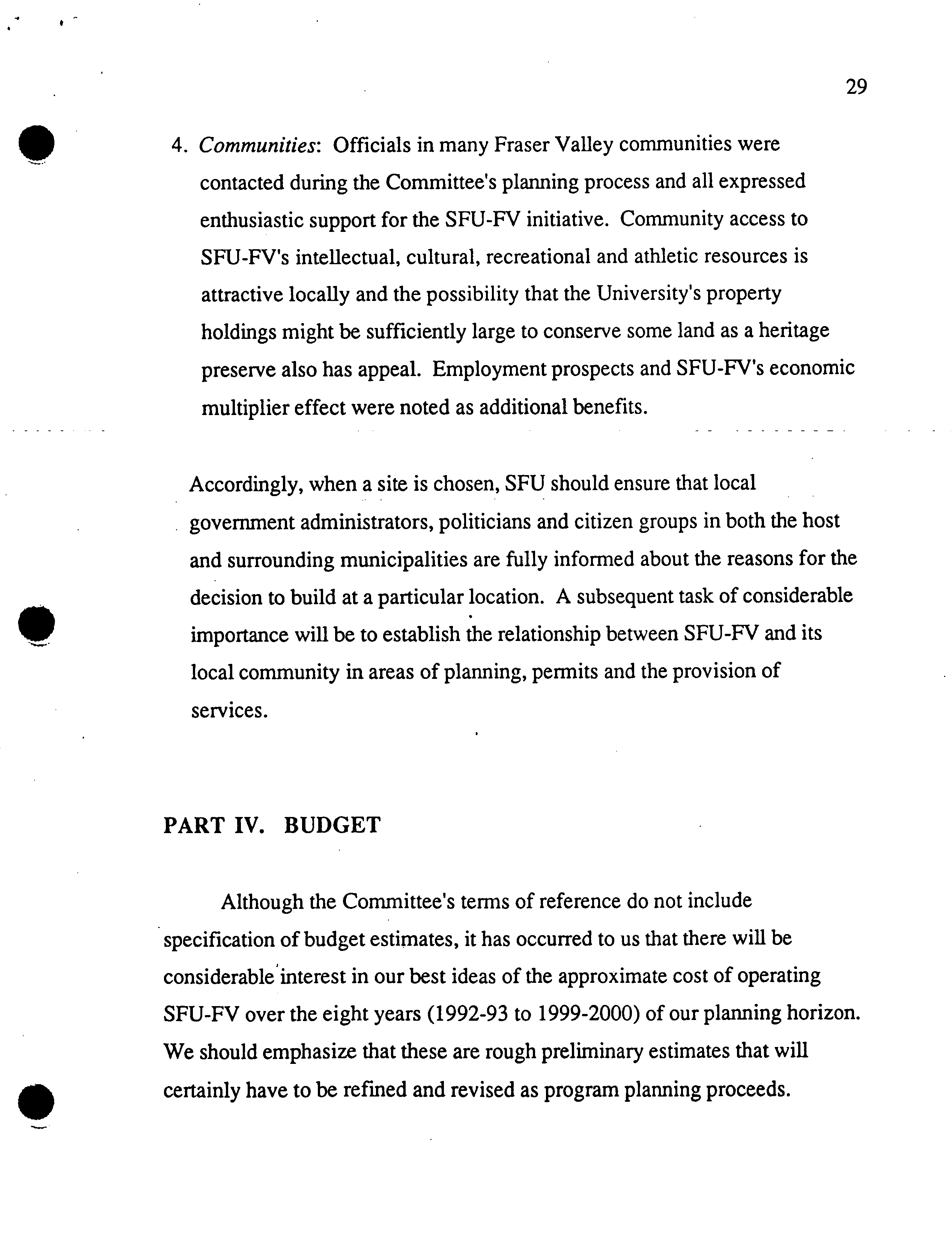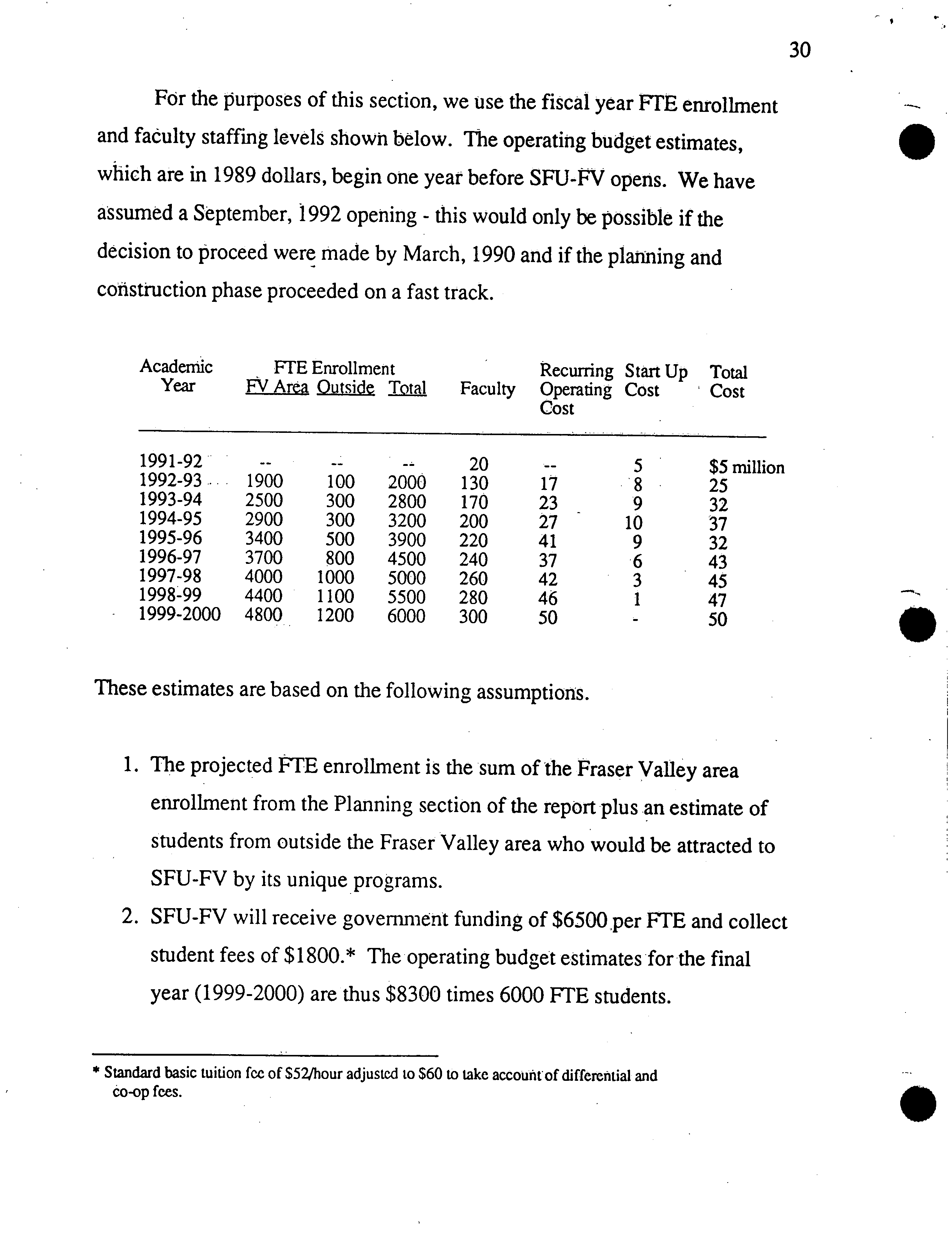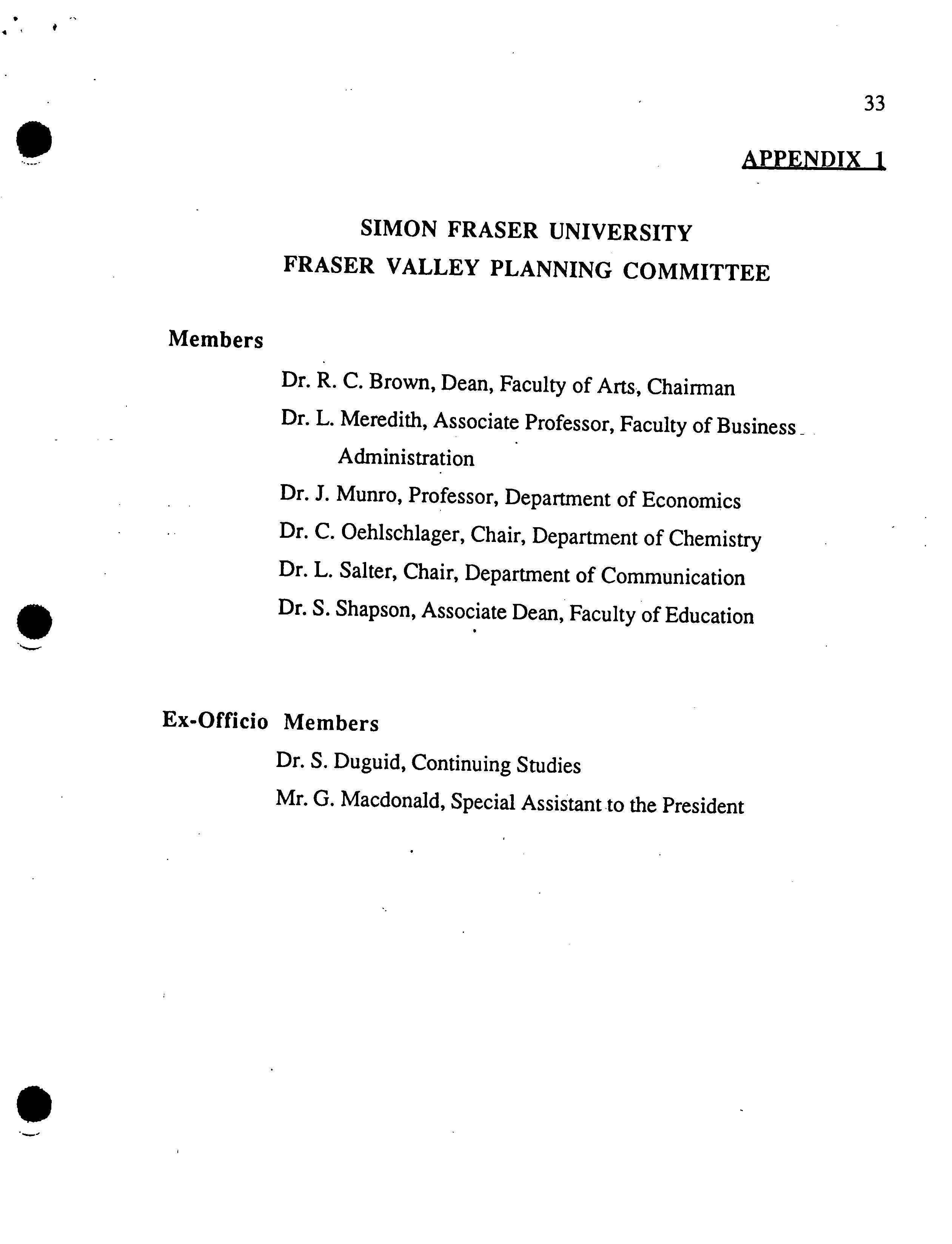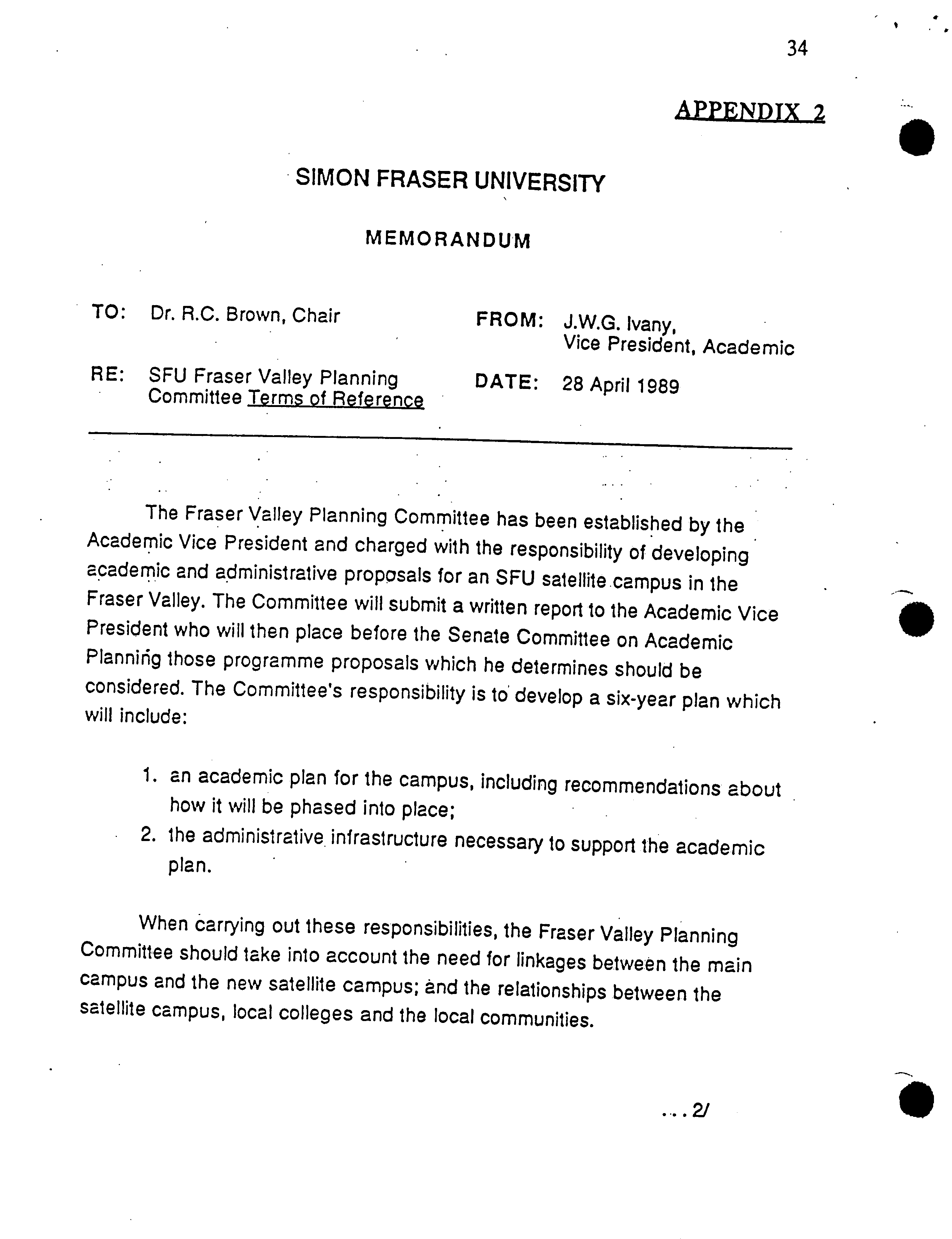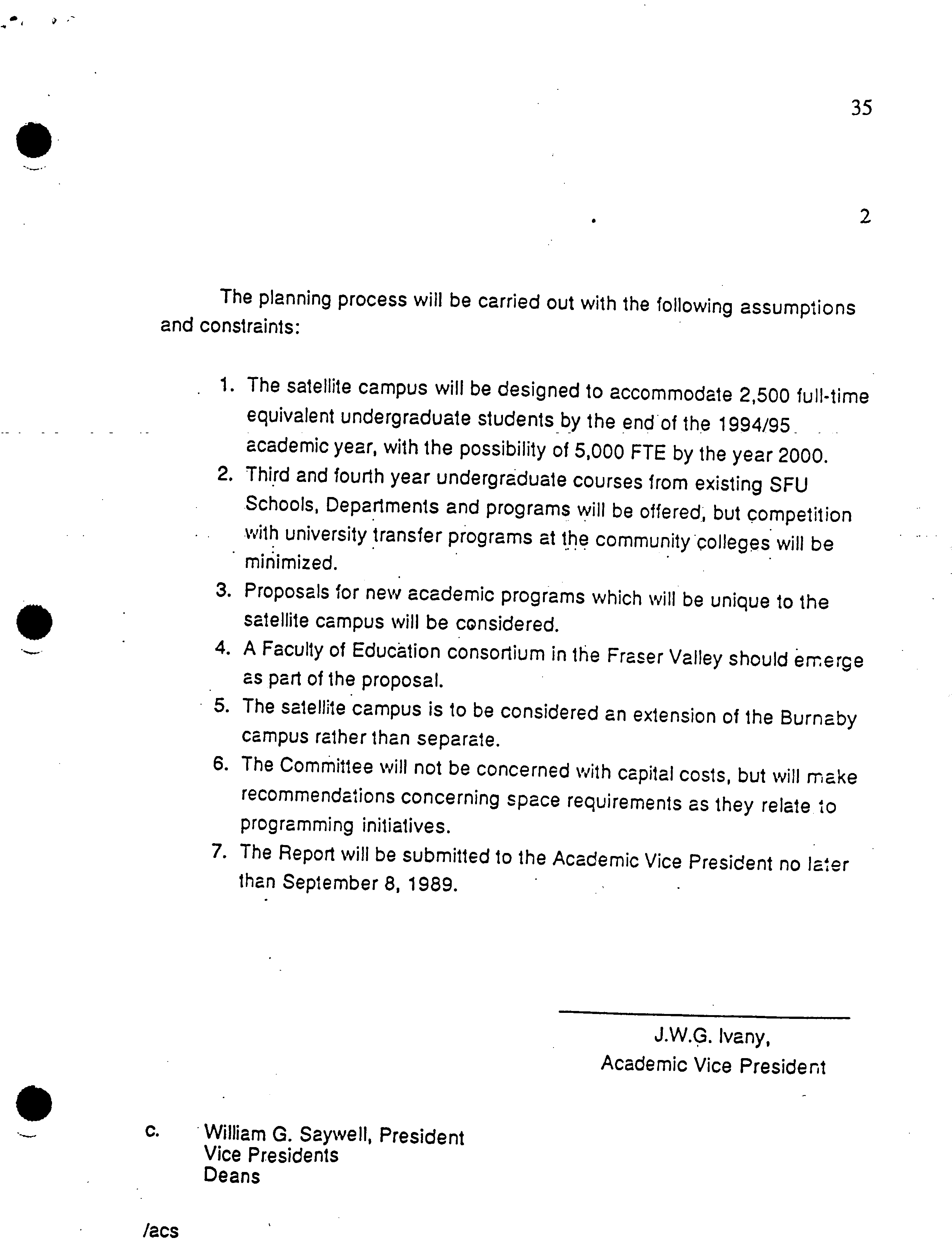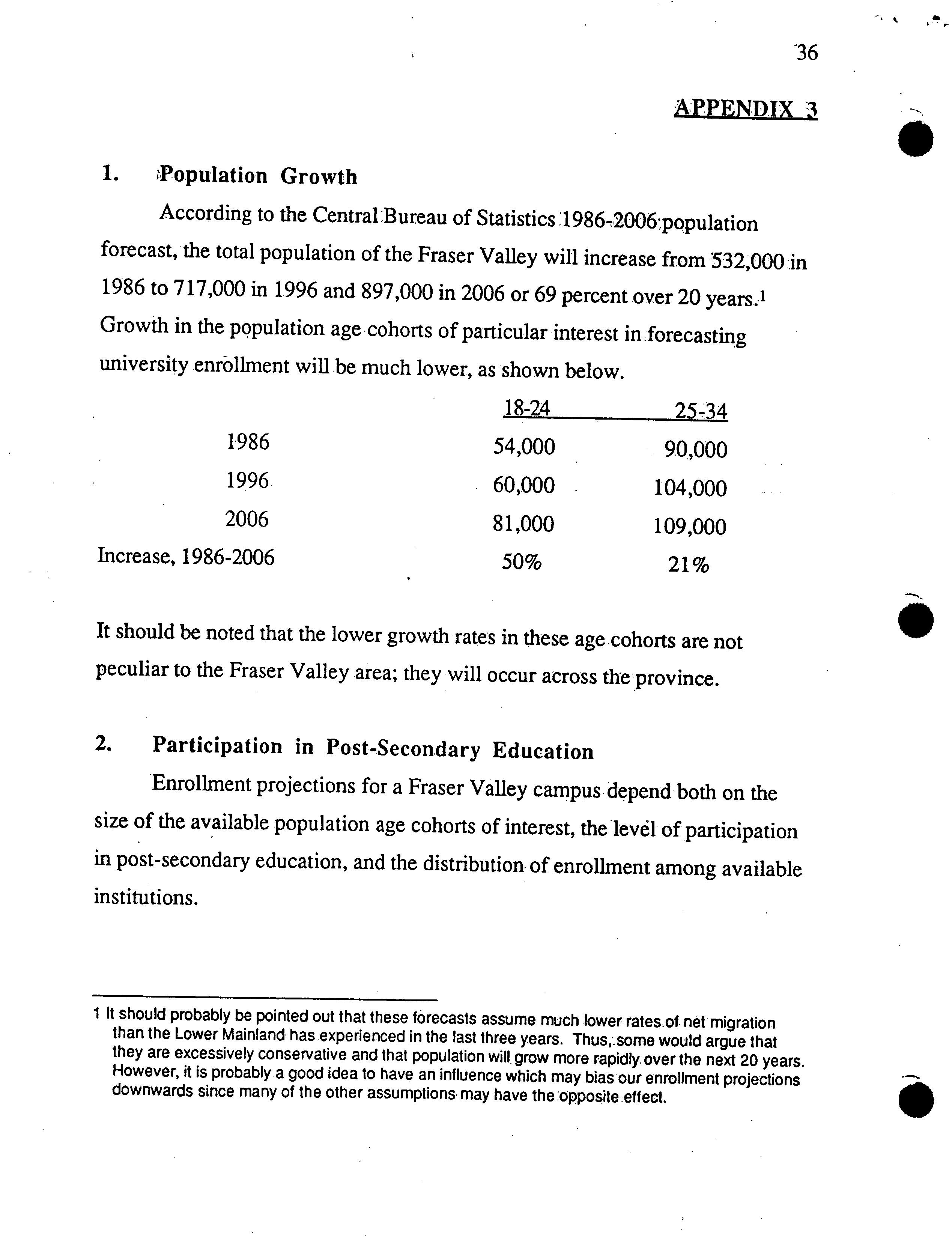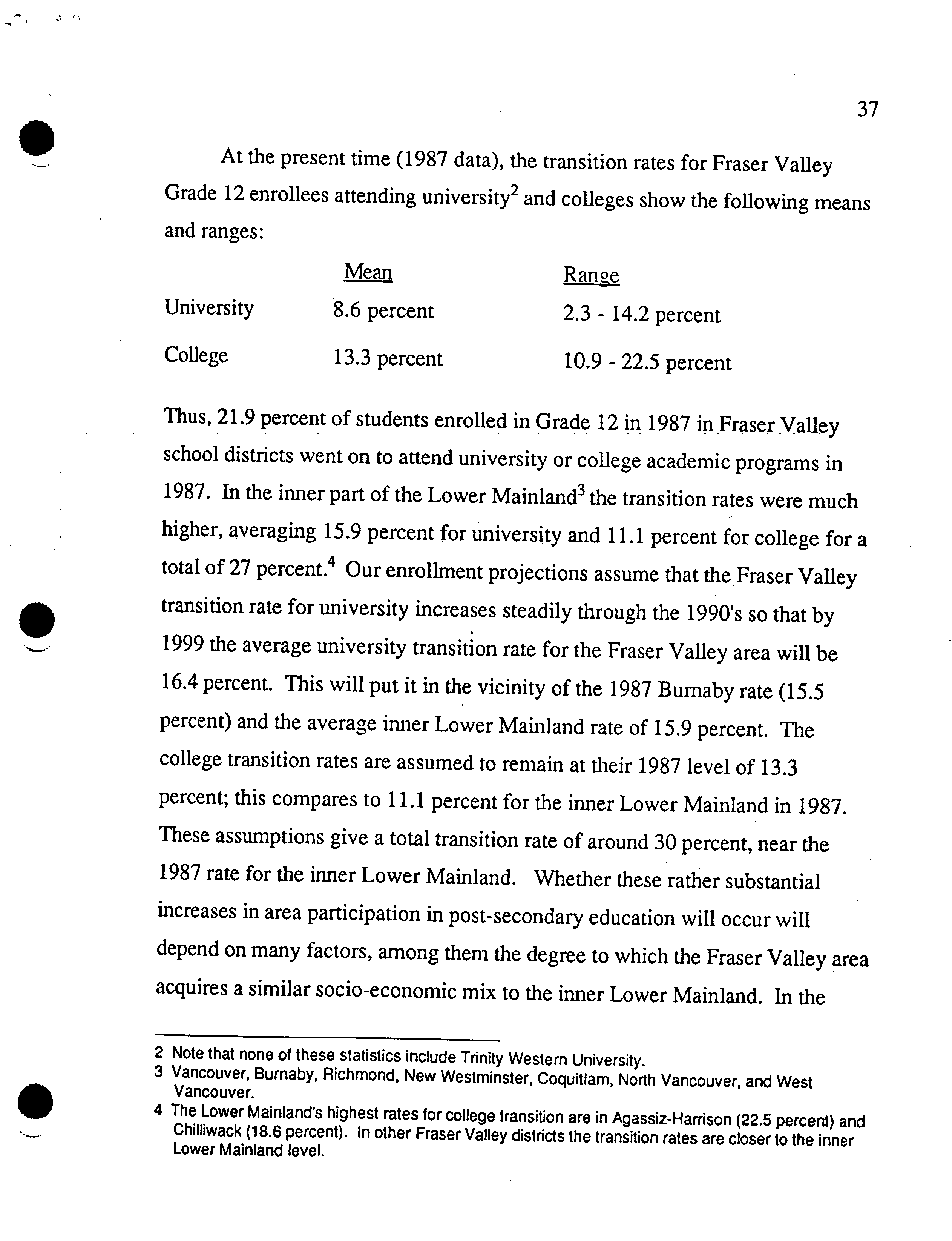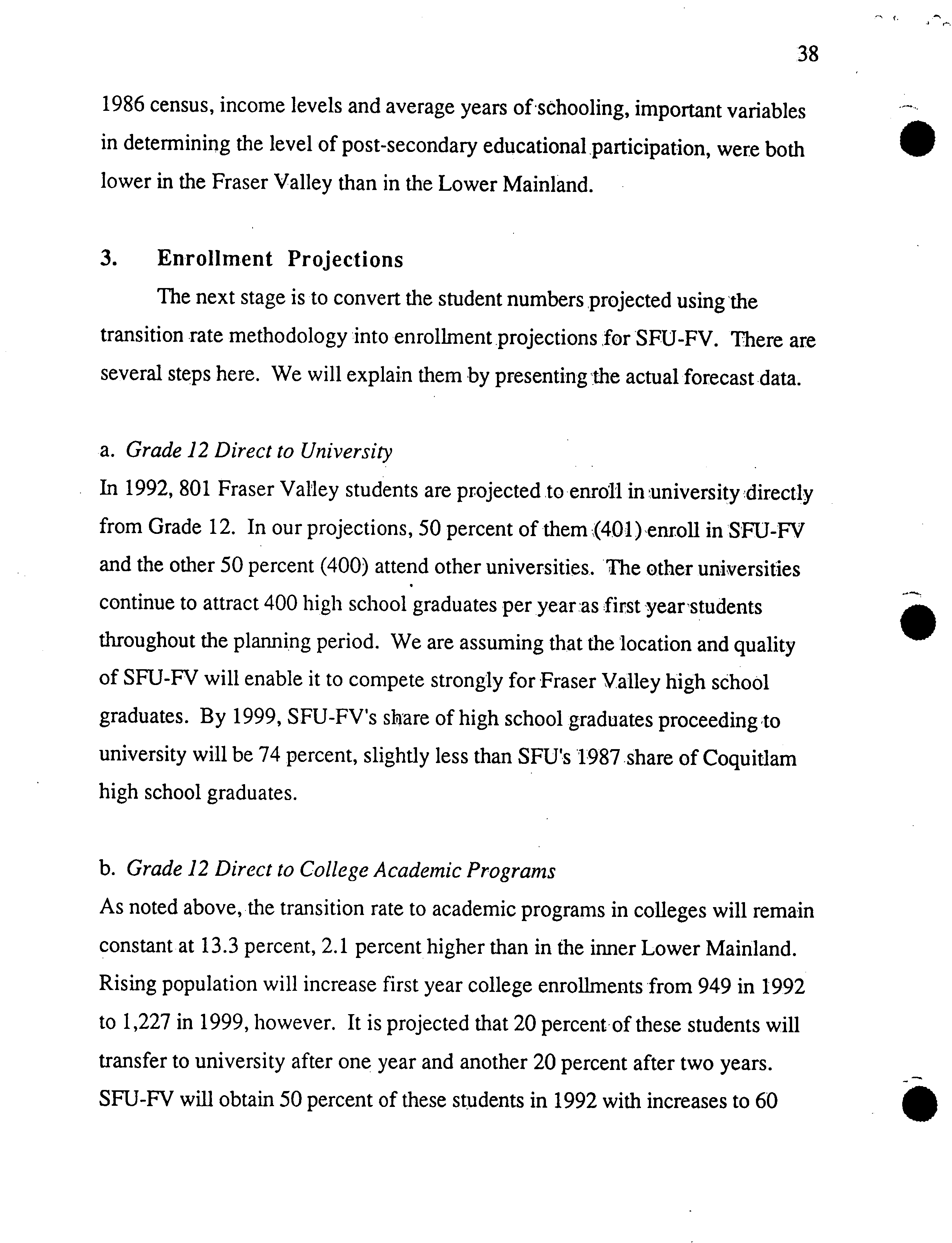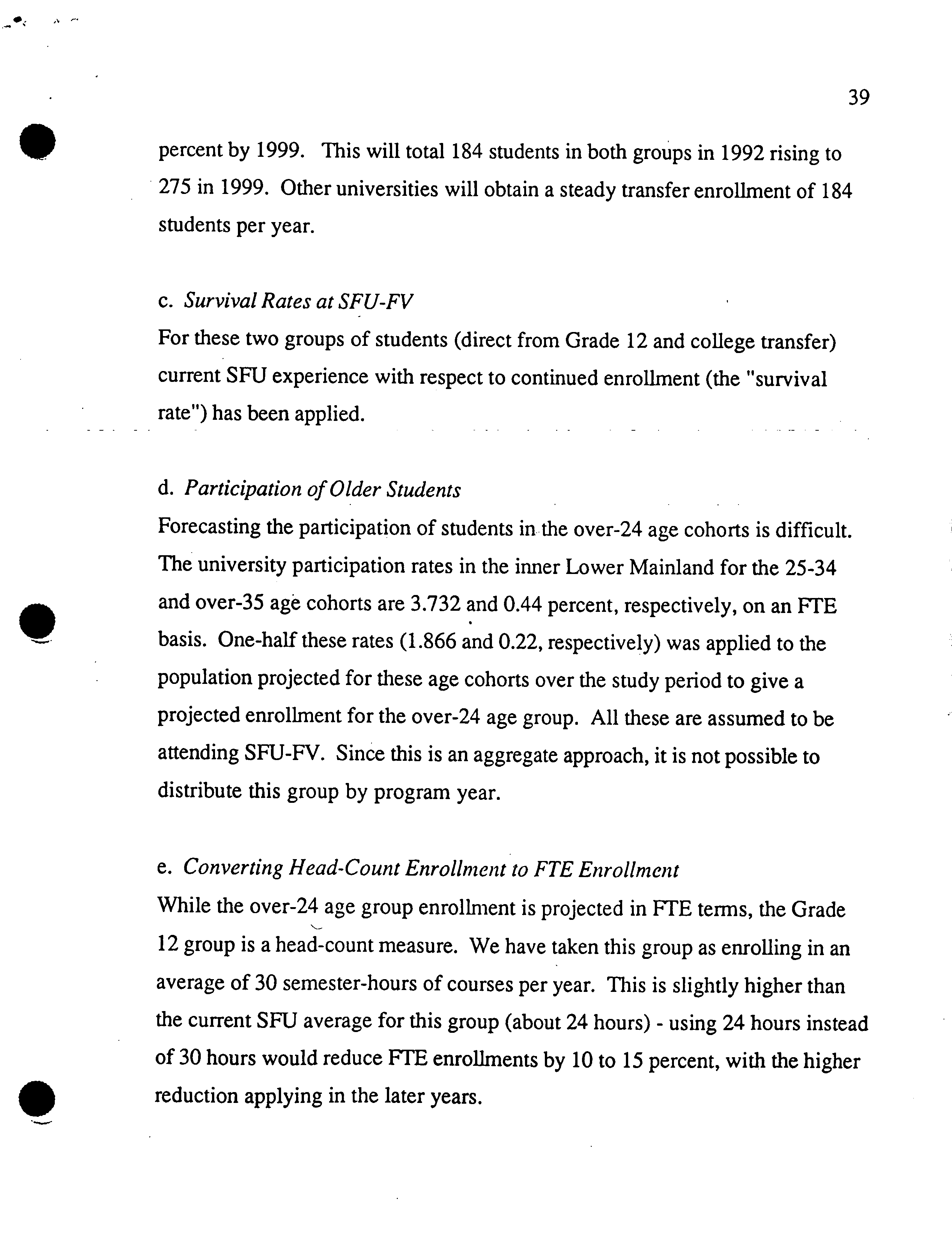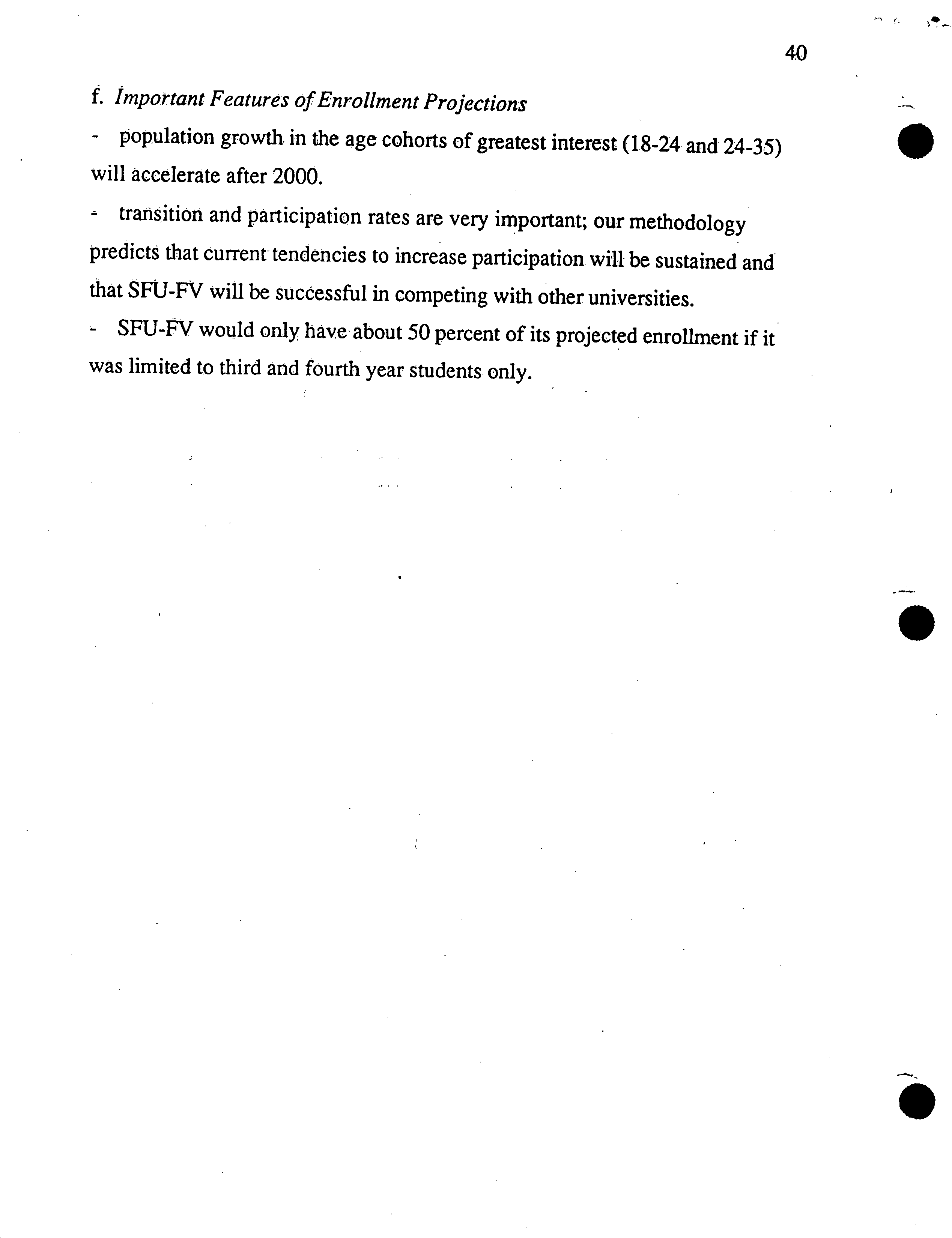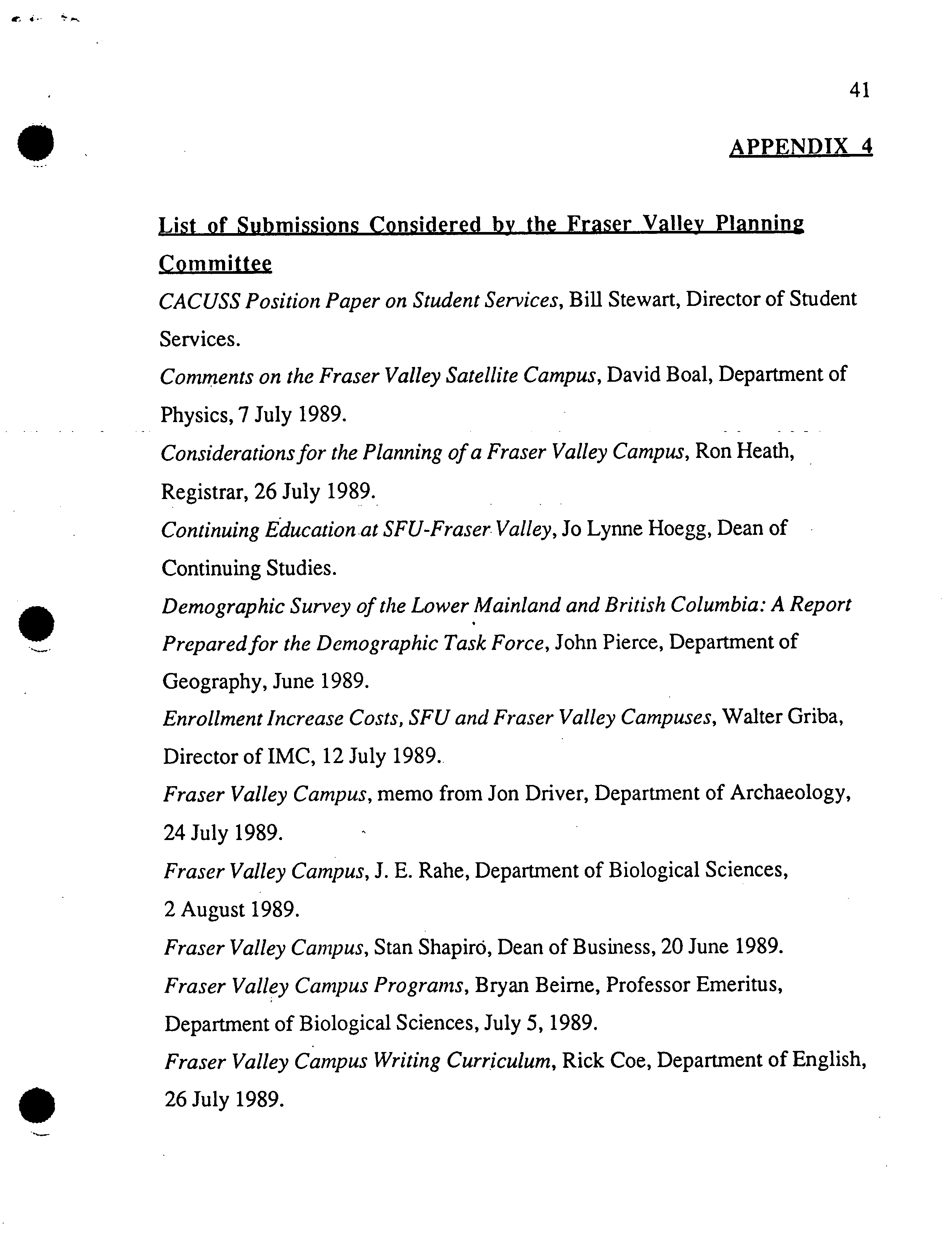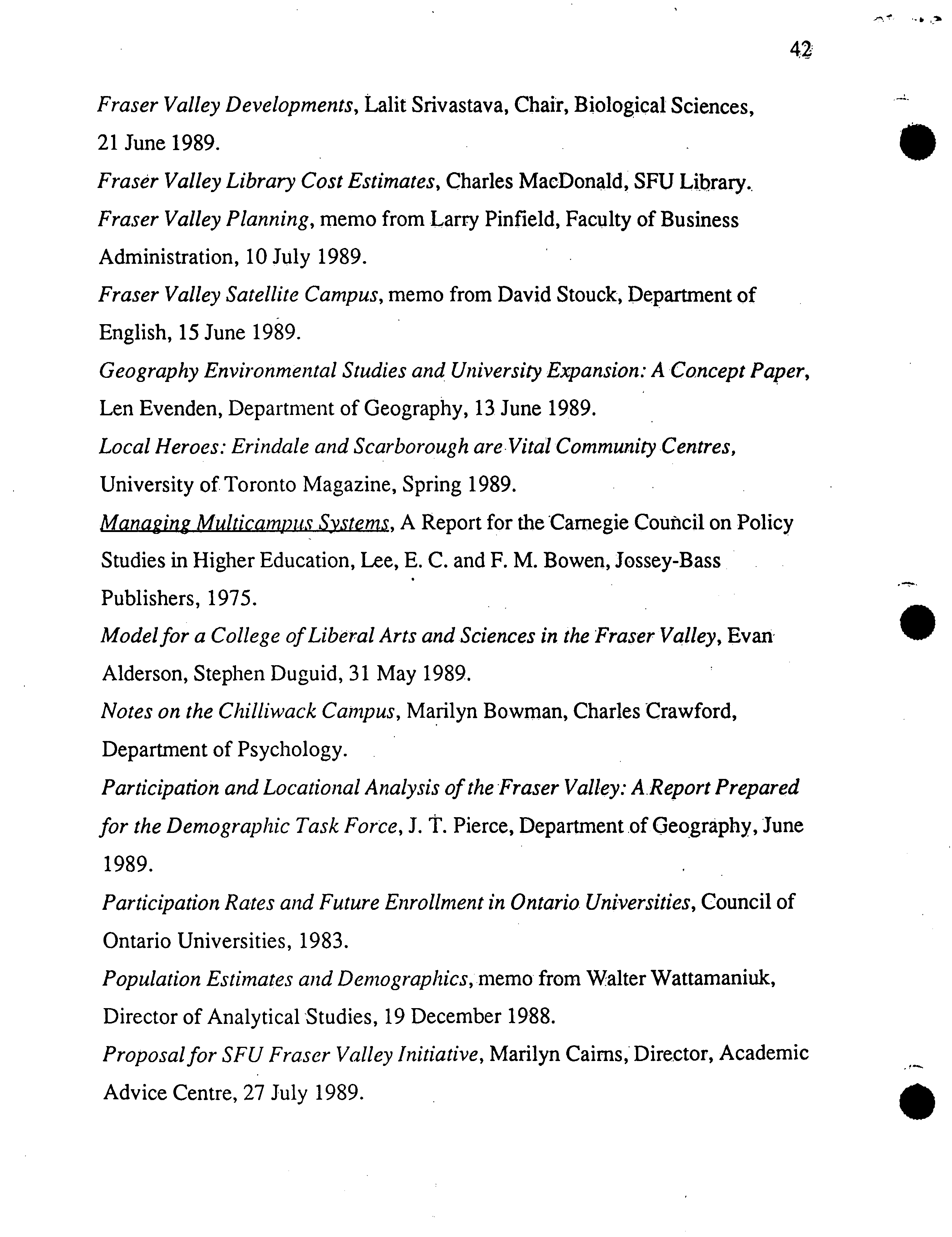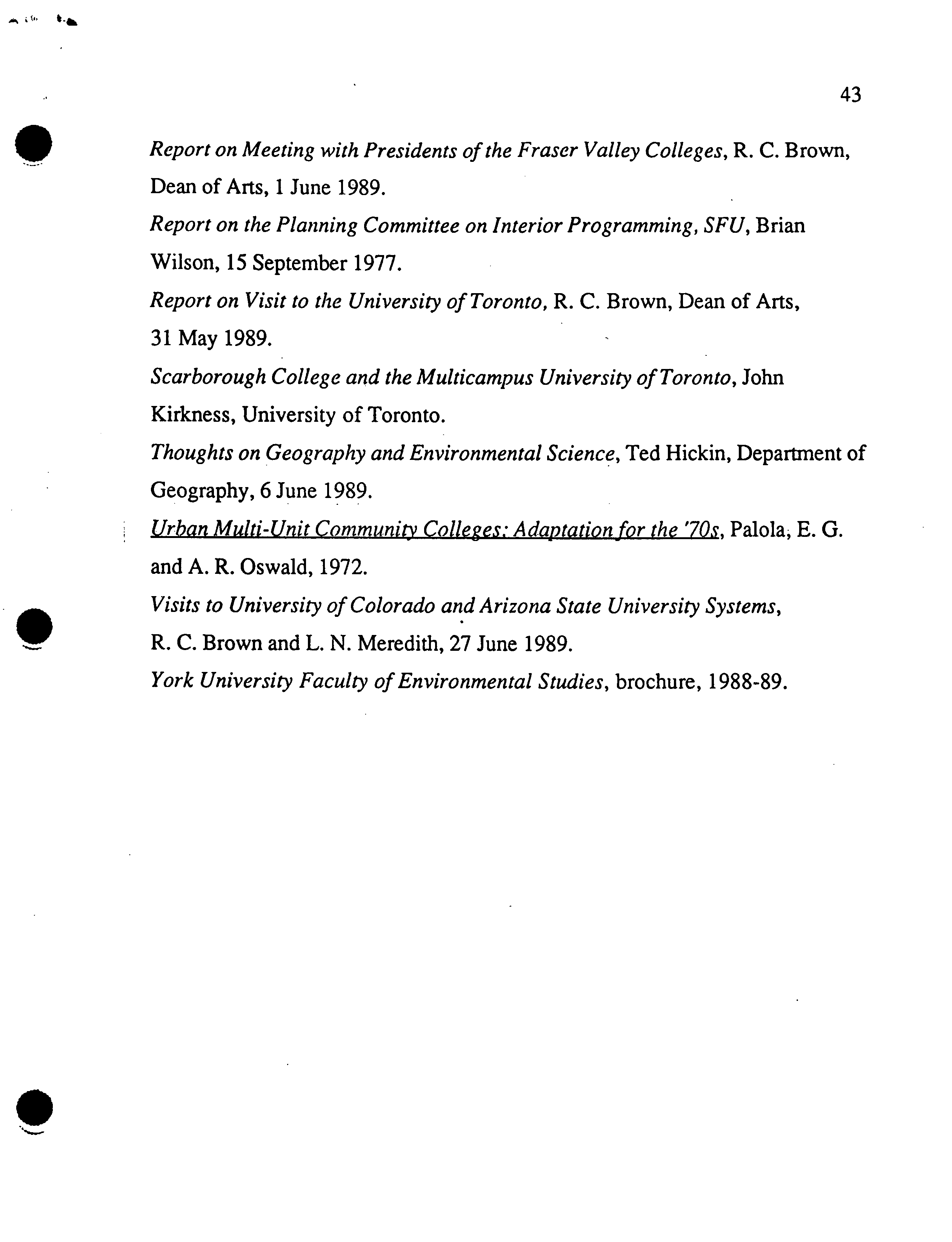p
'FOR INFORMATION
S.89-34
Ii
REPORT
of the
FRASER VALLEY PLANNING
COMMITTEE
.
September 1989
e
/
SIMON FRASER UNIVERSITY
L
VICI-I'RISIDFNT, ACADEMIC
I
BURNABY,
BRITISH COLUMBIA
CANADA V5A 1S6
Telephone: (604) 291-4636
September 18, 1989
Dea
T
r Colleague:
I am pleased to present the Report of the Fraser Valley
Planning Committee as an internal discussion document for
consideration by the Simon Fraser University community. The
Committee's proposal represents one of several possible replies to
the Government of British Columbia's Access Strategy.
•
I invite written comments directed to my office by October 15,
1989. On that date, I have asked Dr. R.C. Brown to re-convene the
Fraser Valley Planning Committee in order to assist me review the
responses in the expectation that a final report can be presented to
the Senate Committee on Academic Planning by early November.
Short as it is, this time line is necessary if the reporting
obligation to government on Fraser
.
Valley access which SFU shares
with the region's colleges is to be met by year end. I thank you in
advance for any contribution you might wish to make.
Since ly,
Ll^
(J.W.G.
Ivany
Vice-President,
Academic
Lj
11
5
CONTENTS
Section
Page
Summary of Recommendations
111
Forward
V
SFU Fraser Valley
1
Introduction
1
Part I: Contextual Issues: Planning & Projections
2
A.
Background
2
B.
The Planning Process
5
C.
Enrollment Projections
7
Part II: Programs and Structures
8
A.
Campus Models
8
B.
Admission Policies
12
C.
Academic Mission and Orientation
12
D. Continuing Studies
19
E.
Instructional Feaiures
20
Part III: Infrastructure and Services
20
A.
Services
20
B.
Location
24
C.
Facilities
25
D.
External Relationships
27
Part IV: Budget
Part V: Consultation and Further Planning
31
Appendices
33
I
111
SUMMARY OF RECOMMENDATIONS
A proposal has been developed for a new campus of Simon Fraser
University in the Fraser Valley (SFU-FV) with the following
recommendations:
1. The proposed campus should open in 1992-93 and grow to 6,000
VIE students in 1999/2000.
2. Simon Fraser University-Fraser Valley should have four
components:
i.
several new Schools offering a full range of degree programs;
ii.
a teacher education consortium;
iii.
degree-completion programs in selected disciplines, and
iv.
new core degree programs in liberal arts and general science.
3. SFU-FV should be built on the south side of the Fraser River
between 30 and 60 minutes' drive from SFU-Bumaby Mountain
under normal driving conditions.
4.
T he campus should:
i.
operate under the same policies and conditions as exist at the
Burnaby and Harbour Centre campuses;
ii.
operate on the trimester system;
iii.
be designed and built as a full campus providing a wide range
of student services and amenities, including student
residences;
iv.
provide high quality academic support for teaching and
research.
5.
An executive committee be established with membership from
SFU-FV and the Fraser Valley Community Colleges to deal with
matters of program and articulation.
iv
g
6. Organizational relationships between SFU-FV and SFU-Burnaby
Mountain should be similar to those present at SFU-Harbour
Centre, i.e.,
i.
a senior official should be appointed with the title Vice-
President, Fraser Valley, reporting to the Vice-President,
Academic;
ii.
two groups of faculty should be appointed. One group will
consist of those who are appointed to a School at SFU-FV.
The other group will consist of faculty who are appointed to
SFU-Burnaby Mountain departments;
iii. administrative and academic services should be provided
though counterpart departments at the Burnaby Mountain
campus.
7. Admissions standards should be identical to those at the other two
-
campuses.
8. The learning environment at SFU-FV should be designed to utilize
the latest in instructional methods and technologies, including
especially:
i.
use of advances in information and educational technology,
including electronic library information and video discs;
ii.
maximum use of computers in instruction;
iii. co-operative education;
iv.
measures to deal comprehensively with student writing skills.
9. Consideration should be given to the possibility that SFU-FV
occupy a site contiguous to a new community college campus site
and with a public school.
10. A consultative process be implemented which would provide a
•
forum for discussion of the report prior to its consideration by the
Senate Committee on Academic Planning.
I
FORWARD
This Report of the Fraser Valley Planning Committee outlines one
response to the recent initiative by the government of British Columbia to
increase access to post-secondary education throughout the Province; namely
the creation of an SFU campus in the Fraser Valley. Simon Fraser University
has been identified by government as an institution with a special role to play in
the provision of access in the Fraser Valley region, an area of high population
growth and projected increased participation rates in post-secondary
education.
It is obvious that Simon Fraser University must respond to the need for
- increased-access to post-secondary education and to the government's request
for early action. A vigorous and innovative response will be possible,
however, only after all the options have been appraised, their separate merits
considered and issues of academic quality and public interest thoughtfully
weighed.
This Committee's mandate was to propose a conceptual and operational
plan for an SFU Fraser Valley campus, not to argue for or against such a
campus or, for that matter, to examine alternatives. To place our proposal in
context, however, it will be important to at least identify these alternatives and
outline their advantages and disadvantages.
1.
A New University: In 1963, the need to meet a rapid expansion of
demand for university education on the Lower Mainland was met by
creating Simon Fraser University. The same option is available to
government once again and a totally new university could be established
in the Fraser Valley. Its advantages would include the capacity to ensure
a wide range of educational programs, the ability to maintain its own
faculty and staff, and the prospect of a separate identity. Its
disadvantage centres on the absence of any economies of scale that other
options offer and more importantly, the benefits which accrue via
association with an established university.
2. Four-Year College: A
University College
could be established at
either Fraser Valley College or Kwantlen College, thus allowing for
degree completion opportunities at relatively low cost. This option's
shortcomings include the likelihood of generating a conflict with the
college's mandate for vocational and technical education, dislocating the
.
college's community orientation, and raising the problem of establishing
appropriate academic credibility in the absence of research programs.
S
vi
. 3. Extension: It would be possible to extend SFU courses and programs
into Fraser Valley locations using the instructional model of SFU's
Evening Program. However, the success of that model on the Burnaby
Mountain campus is largely based on the direct link to an active, existing
campus and on integration with daytime programs. It is unlikely that
extension programs are a long-term solution in the Fraser Valley. They
are a temporary response to be replaced as soon as possible by one of the
other options.
4. Expansion on Burnaby Mountain: The present five-year plan for
expansion at the Burnaby campus will provide space for an additional
1200 FTE students. Theoretically, if the necessary funds were made
available, the campus could be expanded to accommodate the equivalent
number of students that will be absorbed by SFU-Fraser Vally(SFU-
FV). As well, economies of scale would be greater; capital costs
probably would be lower; and an expansion of the Burnaby Mountain
campus would substantially reduce the complexity of administration,
faculty relationships and student program planning which are
commonly associated with multi-campus institutions. While obviously
an attractive option from many perspectives, there are some important
S
drawbacks, including: the potential loss of the character and ethos of
Simon Fraser that would accompany rapid expansion on a single
campus; transportation difficulties and environmental problems caused
by a large increase in the number of commuting students; lack of
sufficient student residences and the poor prospects for adding more;
and the government's desire to provide for access in the Fraser Valley
itself.
Considering all these options and their limitations, the view of the
Committee is that a new Fraser Valley campus for SFU, while certainly not the
easiest path upon which to embark, is the most desirable one for achieving the
goals of improving access in the Valley, meeting the needs of students and
enhancing the academic resources and programs of Simon Fraser University.
S
I
.
SFU FRASER VALLEY
INTRODUCTION
The Fraser Valley Planning Committee has developed a proposal for a
new campus of Simon Fraser University in the Fraser Valley (SFU-FV). This
new campus, like that at Harbour Centre, will have a distinct mission and
identity, complementing the educational opportunities now provided by Simon
-
Fraser and by other post-secondary institutions -in the Province- of British -
Columbia.
There are four components to the proposal:
1.
The creation of several
new schools,
providing university-level
instruction in subject areas central to the emerging needs of the
province. These new schools would be unique to Simon Fraser and to
the Province of British Columbia, and would extend considerably the
educational opportunities available in the province.
2.
The creation of a
Teacher Education Consortium
involving school
districts and colleges in the Fraser Valley, focussing on professional
preparation of teachers, inservice and graduate programs and research
on teacher education and school-related issues.
3. The establishment of
two new degree programs,
a Bachelor of Liberal
S
Arts and a Bachelor of General Science. Each would offer a four year,
structured curriculum stressing interdisciplinary work and intellectual
community.
Is
4. The provision of third and fourth year courses in selected disciplines
and areas of concentration, to complement course offerings at Simon
Fraser Burnaby Mountain and to permit
degree completion. This
would
be co-ordinated with existing and emerging university transfer
programs at the colleges and by first and second year. courses at Simon
Fraser Fraser Valley, where appropriate and in response to student
demand.
PART I. CONTEXTUAL ISSUES: PLANNING & PROJECTIONS
A. Background
In September 1988 the Minister of Advanced Education and Job
Training made public the Report of the Provincial Access, Committee
Access to
A dvanced Education and Job Training in British Columbia.' The
Report
noted that existing participation rates in the Province, are substantially lower
than the national average and:presented a
.
broad set of recommendations, all
focussed upon improving accessibility to post secondary edlication.. and raising
participation rates in colleges, institutes and universities across the Province.
1 Report of the Provincial Access Committee.
Access to
Advanced Education and Job Training in British
*
Columbia.
Ministry of Advanced Education and JobTraining, Victoria, B.C. 1988.
3,
0—
According to the Report, degree completion accessibility was to be
improved regionally through the development of "university colleges" at
selected existing college sites outside the Lower Mainland and southern
Vancouver Island and overall participation was to be enhanced by further
development of the university transfer programs at the remaining colleges in
the system and by providing "predictable funds to allow institutions (the
universities) to maintain quality of programs and upgrade space and
equipment". The Report also contained a recommendation that there be
"further exploration of the potential of a distinctive 'University of the North'."
In March 1989, the Minister- announced that a number of the
recommendations in the Report were to be implemented. Specifically, it
became government policy to:
raise B.C. participation rates to the national average by
1995,
and in
order to achieve their objective, funding was approved to add 13,200
new full-time undergraduate students and 1800 new graduate students to
the post secondary system.
facilitate regional access by the creation of three "university colleges" in
Kelowna, Kamloops and Nanaimo and by improving university transfer
programs elsewhere. The three existing universities were offered
funding to assist the designated colleges in developing their third and
fourth year programming.
T
he SFU administration reacted quickly to the announcements by
pointing out to government that the Access Committee Report noted that
4
4
population
s
in
.
the Lower Fraser Valley was expected to grow more rapidly
than any Other
ara
of the Province and that, therefore the University could
contribute best to the access program by focussing its attention on that region.
'I
In
April the Minister asked the Presidents of SFU, Douglas.College,
Kwantlen College and Fraser
V
a
lle
y
College to develop ajoint proposal no
latr than l3eember 1989 for the delivery of advanced education and job
training in the Valley. In April 1989, recognizing that one of the options
available t0 improve, accss in the Valley was for SFU to establish a campus
there, the Vice-President, Academic established The Fraser Valley Planning
Committee (FVPC).
The terms of reference for the Committee included the development of
academic and administrative proposals for an "S.F.tJ. satellite campus"
2
. The
Committee's responsibility was to develop a six-year plan which would
iñôlude:
1.
An academic plan for the campus, including recommendations about
how it will bephased in;
2.
The administrative structure neëessary to support the academic plan.
The Committee:also was, directed to take into account-the need for linkages
between the main campus and the new.campus and the relationships between
the new campus, local colleges and the local. communities.
2 See Appendix 2.
I
5
0
B. The Planning Process
T
he planning which led up to the presentation of this Report began in
May, 1989. During May and June, research was undertaken to develop
background information on other multi-campus universities in Canada and the
United States. Visits were made by members of the Committee to the
University of Toronto (St. Georges, Erindale and Scarborough campuses), the
- - -
University of Colorado (Boulder and Denver campuses) and Arizona State
University (Tempe and West Valley Campuses) where in addition to
documentary data, information was gathered on the successes and failures of
those institutions and advice was solicited about the best way to design a multi-
campus system.
Also in May, consultation was initiated in the Valley through meetings
with Presidents and Deans in the local colleges, School District Super-
intendents, and local planning authorities. At the outset of this planning, it was
decided that collaboration with the region's colleges and school districts was
essential in order to be sensitive to their concerns, in particular that the unique
character and mission of the colleges should not be jeopardized. It seemed
essential that the proposal be developed through consultation with groups and
individuals in the region to be served. The Committee has been impressed by
the enthusiasm and support SFU-FV has received from everyone consulted in
the Valley.
A parallel process of consultation was initiated by members of the
Committee inside the University Community. Meetings were scheduled with
individual members of faculty, Deans' Advisory Committees, several
departments, the Faculty Association, and senior members of the
Administration both to inform the community about the project and to solicit
ideas and assistance. The internal consultation process was very helpful to the
Committee. The many full and frank discussions served to articulate the
problems facing the proposed campus and to provide suggestions for new
programming which might be developed. Finally, a number of excellent
position papers were prepared by academic and administrative support unit
directors which provided guidance on systems and services necessary to
develop SFU-FV and to link it to the Burnaby campus.
In May, Dr. John Pierce. of SFU's. Geography Department was appointed
as a consultant to work with a "Demographic Task Force" which included as
members the Analytical Studies officers from SFU, Kwantlen College, Fraser
Valley College and Douglas College. The purpose of that study was to provide
a synopsis of population forecasts and participation rates in higher education
for the Lower Mainland of B.C. with special attention paid to. the growth
performance of municipalities of the Fraser Valley.
3
The report of the "Task
Force" was received by the Committee in late June.
4
The Demographic Task
Force's conclusion is that "demands for educational services, are expected to
expand greatly in the Fraser Valley as it captures a larger share of younger age
classes of the population and participation levels 'converge' with respect to
Vancouver and its environs."
3 In this report the Fraser Valley area (FV) includcs'thefollowing school districts: Delta, Surrey, Langley,
Abbotsford, Agassiz-Harrison, Chilliwack, Maple Ridge, and Mission. The area definition was based on the
assumption that the SFU-Fraser Valley (SFU-FV) campus would be located south of the Fraser River and
that a bridge would be built across the River near Haney/Fort Langley sometime in the 1999s.
4 J.T.Pierce, "Demographic Survey of the Lower Mainland of British Columbia," A Report Prepared For The
Demographic Task Force; SFU Office of Analytical Studies, June 1989.
7
C. Enrollment Projections
The prospective enrollment at SFU-FV is a very important starting
point for our planning outline. The most important factor in initiating this
planning effort was the perceived need to serve a growing student population
in the Lower Fraser Valley. Thus, we begin with an analysis of the prospective
size of a Fraser Valley campus.
The Committee's projections of SFU-FV enrollment are based on the
Report by John Pierce and further analysis by Walter Wattamaniuk, Director
of Analytical Studies at SFU. The projections indicate that the targets of 2500
FTE students in 1994/95 and 5000 FTE students in 1999/2000 specified in the
.
Committee's terms of reference can be met, if the Fraser Valley campus:
offers a four year academic program;
ee
is successful in increasing university participation rates in the Fraser
Valley to approximately the Burnaby level by 1999, and:
is able to attract students from outside the Fraser Valley area to
study in the unique programs which will be offered at the campus.
In addition to the above three points, it is assumed that growth at SFU-Burnaby
Mountain will be held to the presently planned 1200 FTE undergraduate
students in the period 1989 through 1995. A summary of the enrollment
projections is shown below:5
I*
5 A full discussion of the methodology used to generate these numbers is included as Appendix 3.
[i]
Grade 12 and
College Transfer
Over-24
Total
1995199419931992
2003
15961113
586
1377136313681334
3380
2959
2481
1920
19971996
2595
2271
1404
1391
3999
3662
19991998
3371
2935
1430
1418
4801
4353
PART II. PROGRAMS AND STRUCTURES
A. Campus Models
The Committee has spent a substantial amount of its time considering the
relationships between SU-FV and the rest of the University. This topic has
also been prominent in discussions of SFU-FV within the University and was
emphasized in the field visits made by members of the Committee to other
campuses. While the precise nature of SFU-FV's relationship to the University
would be determined in the course of its operation, it is important to
recommend several essential features of the organizational and operational
parameters of SFU-FV at the outset because they transcend any particular
program structure that SFU-FV would develop.
Based on the interviews conducted on other campuses, the Committee
concluded that multi-campus universities are most successful when:
0
1.
each campus has some programming which is unique and which has
strong research and graduate programs in addition to undergraduate
programs;
2.
programs are not simply an extension of general programming from the
"main" campus;
3.
all campuses .have the same standards and expectations for faculty and
students;
• 4. all components (campuses) are perceived to be equal partners in the
multi-campus consortium;
5.
each campus has a full range of student, staff and faculty facilities,
including student residences.
The interviews at other campuses also showed clearly that in cases where a
satellite campus was limited strictly to the extension of programs which were
also offered on the 'main' campus, the satellite unit inevitably was
characterized as being inferior. This was especially true in cases where
different standards of admission for students were employed and faculty
without active research programs were transferred from the 'main' campus to
teach at the newer satellite campus.
In order to avoid these problems SFU-FV must be an integral part of
S
Simon Fraser University whose faculty and staff work under the same policies
10
and conditions as in the rest of the University and whose governance 'structures
are connected to those of the rest of the University.
This will mean, for example, that:
1.
SFU-FV not have its own Senate or Board of Governors, although it
should have its own convocation ceremonies;
2.
SFU-FV operate on the trimester system and its programs be related to
those of SFU-Burnaby;
3.
The campus of SFU-FV be designed and built as a full campus providing
a wide range of student services and amenities, including student
residences and recreational facilities;
4.
SFU-FV also provide high quality academic support for teaching and
research.
These features are essential if SFU-FV is to appeal to students,. faculty, and
staff as a place to study and work and it must do this if it is to be an operation of
quality.
Organiz ationally,
SFU-Habour Centre provides: an attractive model,
although the greater size and scope of SFU-FV means that its organizational
relationships will have to include more independence for many administrative
and academic functions. The senior official at SFU-FV should be' given the
title of Vice-President, Fraser Valley with a reporting relationship to the Vice-
11
President, Academic. This Vice-President will have administrative
responsibility for all
aspects of the SFU-FV campus and will have whatever
academic responsibility is required to deliver the programs and other aspects
of the academic operation of the campus. With respect to programs which are
operated only at SFU-FV,.the Vice-President will function as a Faculty Dean.
Faculty members
who work at SFU-FV will fall into two groups, one
group consisting of those who are appointed to a School at SFU-FV. We
envisage that SFU-FV Schools will be staffed entirely by faculty appointed to
SFU-FV and will be headed by Directors who will report to the Vice-
President, Fraser Valley in his/her role as Faculty Dean. The other group
consists of faculty who are appointed to regular SFU departments. These
faculty will have a dual reporting relationship - to their Department Chair and
Dean at SFU with respect to performance evaluation and other contractual
matters and to the Vice-President, Fraser Valley with respect to their assigned
work in SFU-FV teaching programs. While this arrangement may appear
cumbersome, we believe it is necessary to create a strong relationship between
the main SFU campus and SFU-FV. This will contribute to hiring success at a
time when a shortage of good applicants for faculty positions is expected as
universities across Canada begin to replace retiring faculty hired during the
1960's expansion.
Some courses may be offered on an extension basis by faculty provided
from the Burnaby Mountain campus or by sessional instructors, with
administrative and financial arrangements similar to those in effect in other
extension programs, such as Harbour Centre. Care should be taken to ensure
that only a limited number of courses at SFU-FV could be offered on this basis
12.
in order to avoid the problems associated with excessive re1ianceor the
extension model.
A dministrative and academic services will
be provided through
counterpart departments at the Burnaby Mountain campus Jn'.most:casesthe
head of the operation at SFU-FV should report to
: the head Of the appropriate
SFU department. For example, the person in charge of the library
, at SFU-FV
should have a direct reporting relationship to the University Librarian.
Particular aspects of some services are discussed below in the Services section.
B.
AdmissiOn Policies
It is imperative that Fraser Valley not become a second tier of Simon
Fraser University. Fr this reason, admissions standards will be identical at all
three campuses of Simon Fraser University, Birnaby Mountain, Harbour
Centre and Fraser Valley. Demand at each site is likely to be equally pressing,
as excellent faculty
Will
be attracted to the Fraser Valley canipu by the
combination of specialized offerings, graduate program opportunities and
research facilities. Students will be encouragedta pursue theii'studies ata
single campus because of the different missions and curricula- offered at each.
C.
Academic Mission and
Oriëntatioñ
T he Fraser Valley campus will have a-unique mission and structure:of
course offerings consisting of four components:
13
1
0
(1) the creation of several new schools, providing university level
instruction to meet emerging needs of the Province of British Columbia;
(2)
the creation of a Teacher Education Consortium, with schools and
colleges in the Fraser Valley, providing professional teacher
preparation, inservice and graduate programs, and research on teacher
education and school-related issues;
(3)
the provision of degree completion programming in selected disciplines
and areas of concentration; and
(4)
the establishment of two new degree programs, a Bachelor of Liberal
.
Studies and a Bachelor of General Science, each offering a structured
curriculum stressing interdisciplinary work and intellectual community.
1.
The Creation of New Schools:
Such schools would have a thematic focus on a specific topic or problem,
drawing together expertise from several disciplines and establishing strong
relationships with government, industry and members of the community.
A number of proposals for such schools have been presented to the
planning committee, including the following: (a) Environmental Studies;
(b) Health Services; (c) Aerospace Engineering; (d) Small Business
Administration and Community Economic Development; (e) Applied
Social Policy; (f) Journalism Education; (g) Information Systems;
(h) Earth Sciences.
T
he committee has neither developed nor evaluated these proposals, but
several can be described briefly to give a picture of-what is intended by this
initiative.
(a)
School
of
Environmental Studies:
A recent comment by a faculty member makes an eloquent Statement
about the need for a School of Environmental Studies. 'He 'says,
There can be little doubt that the growing concern about the deleterious
effects
of human activity on the environment will become one of the
most important scientific and social issues of the new century. Already
we see signs that the persistent voices of environmental scientists slowly
are being recognized and that a new political will to address
environmental problems is beginning to emerge here in Canada and
elsewhere. The expression of international concern is a particularly
significant development because many of the environmental problems
we face are world problems requiring global solutions. ... The
University must play a central part in the effort to develop and sustain
among its graduates a heightened awareness of the critical nature of
these environmental problems.6
There are programs or faculties of Environmental Studies at York
and Waterloo
.
, but no similar initiative in the Western, Provinces.
Some planning has been done at Simon Fraser by the Departments of
Geography, Biological Sciences, Chemistry and Natural Resource
Management. As well the Department of Philosophy and the Institute
for the Humanities at Simon Fraser have both done work in the area of
environmental ethics, as has the Department of Economics in the
design of:environmental policies.
14
6
Ted Hickën to Roger Hayter, 6 June 1989.
15
0
b)
School of Health Services:
The demand for a wide range of health services is growing at an even
faster rate than the population, and there are well documented
problems with providing adequate training for health services
personnel and administrators. The proposed School of Health
Services will complement the professional programs at the colleges
and universities in the province. In particular, it will draw upon
expertise at Simon. Fraser in Kinesiology and Gerontology, and upon
the experience of the Faculties of Business and Continuing Studies
with special programs designed for health service administrators.
(c)
School of A erospace Engineering:
None of the British Columbia universities has programs in
Aeronautical or Aerospace Engineering, yet industries that depend
upon these disciplines are increasingly important in the province and
the region. This situation provides an excellent opportunity for a
partnership of Simon Fraser's Department of Physics and its School
of Engineering with a number of private companies now providing
equipment and services for aerospace development.
Each of the approved schools might reasonably be expected to offer
undergraduate courses in conjunction with the Burnaby Mountain campus;
specialized courses at Fraser Valley; graduate courses; and a sustained
program of world class research capable of attracting students from across
the province and throughout Western Canada.
L^
16
2. The Creation of a Teacher Education Consortium:
0
Two developments will require an expansion by the Faculty of
Education and the Fraser Valley provides a desirable setting for this to
occur. First, it is anticipated that the demand for new teachers will increase
rapidly and, second, new programs will be required in conjunction with the
implementation of the curriculum triggered by the recent Royal
Commission on Education. To meet these needs, a teacher education
consortium is proposed,, involving the school districts and colleges in the
Fraser Valley and the Faculty of Education and appropriate Arts and
Science departments. at Simon Fraser.
The teacher education consortium builds upon expertise that the Faculty
of Education has developed with several similar programs, including the:
Alaska Highway Consortium on Teacher Education and the Surrey/SFU
Secondary. program. Unlike these initiatives however, the Fraser Valley
teacher education consortium will include a research and development
component.
The consortium will develop and implement new programs across the
entire continuum from the academic and professional preparation of
teachers (and possibly paraprofessionals), through inservice and graduate
programs and it will include research on teacher education and school
related issues.
Anticipated features of the consortium would include:.
17
40
(a) a joint governance structure cOrn
.
posed of representatives from the
school districts, colleges and Simon Fraser University;
(b)
clustering of student teachers in selected schools, which would
function as teacher education "labs";
(c)
new opportunities for training and support of sponsor teachers; and
(d)
the creation of a 'field centre' for the implementation of new
curricula and in-service programming. Research and development
initiatives would maximize the impact of investment in educational
research for the benefit of consortium members, and facilitate the
establishment of a research base which would serve as an integral
part of educational analysis and decision making.
3.
Degree Completion in Selected Undergraduate Disciplines:
For first and second year courses, Simon Fraser would draw
extensively upon the existing and emerging university transfer programs at
the colleges. Simon Fraser would complement these offerings and respond
to student demand where it was warranted by also providing instruction at
the lower levels.
Courses would be offered at the third and fourth year level in selected
disciplines and areas of concentration. Such courses would permit
coordination with university transfer programs and degree completion at
Fraser Valley.
.9
18'
4.
The E
*
stablishment
of Two New Degree Programs:'
The proposed programs 'ar&a BachelOrMf Liberal 'ShidiCs and a
Bacheloiof General Scieñcè. Each would-'offer afàuryear;.structured:
curriculum stressing interdisciplinatywork andintellëctuat community.
There are' several rationales for thes programs,. each
,
of
is unique.
to British Columbiä First, they are well suited to a' serni-urbanuniversity
campus in which it is possible to foster a strong. sense of community..
Second, as interdisciplinary programs each is intended to be responsive to
the new global envirohrnent, which requires people to be adaptable to
changes in the economy, job profiles, and technologies. Third, these are
programs that can be mounted with a small number of faculty and a limited
number of electives. Finally, and perhaps most important, these programs
add an important intellectual dimension to the university curriculum,
depending as they do On the integration of disciplines and development of
capacities for critical thought.
A third degree program might be added at some future point to the list"
namely, a Bachelor of Technology. This would give students in selected
college technology
I
programs a degree program into which 'they could
transfer at least sOme of their technology -courses. Again, :the:ernphasis in
this program would be on the provision of a structured curriculum, with a
limited number of electives, drawing upon a variety of disciplines and areas
of expertise at Simon Fraser University.
.
19
D.
Continuing Studies
Continuing education programs will be an important part of the
academic activities at SFU-FV. These programs will centre on four areas:
1.
Support for Schools. Continuing Studies will support the projected new
areas of academic development via professional development courses,
seminars and conferences and by assisting faculty in building networks
in the specialized communities being served by these new areas (e.g.
environmental groups, planners, health workers, engineers).
2.
Professional Development Programs - Develop and administer a series
.
of professional development programs which build on the academic
expertise of the University, reflect the interests and needs of the Fraser
Valley community and complement the continuing education programs
of the colleges.
3.
Part-Time Study - Coordinate and support efforts by SFU-FV to supply
courses and programs for part-time and adult students and, when
necessary, act as the advocate within the institution for the needs and
interests of these and other groups of non-traditional students.
4.
Conference Services and Marketing - Administer conferences, seminars
and symposia for the University and the community, and provide
coordination and support for general marketing and promotion needs
for the Fraser Valley campus.
20
E.
Instructional Features
The learning environment at SFU-FV should be designed to utilize the latest
in instructional methods and technologies. We should take advantage of the
opportunity to build in capabilities and features which are beyond the ability of
a 25-year old campus to make full use of because of physical and human
constraints. Our preliminary thinking has identified the following features
which should be considered for SFU-FV:
1.
Use of advances in information and educational technology including
electronic library information and videodisc.
2.
Maximum use of computers in instruction.
3.
Co-operative education available in all programs, although not
compulsory across SFU-FV.
4.
Measures to deal comprehensively with student writing skills.
PART III. INFRASTRUCTURE & SERVICES
A.
Services
The Committee received many useful submissions from academic and
administrative service departments. These offered advice -on how best to
provide services at a smaller remote campus while stilltakingadvantage of the
.
21
0
economies of scale which are available through combining the provision of
services at all SFU locations. More detailed consideration of how to manage
this will be required in the future but the following summary reflecting input
from the Library, Academic Advice Centre, Registrar's Office and the
Instructional Media Centre will give some indication of the issues and
problems involved.
1. Library:
The establishment and maintenance of a core book collection at
the Fraser Valley site will undoubtedly constitute one of the largest initial as
well as on-going costs that the university will have to undertake. These costs
will be unavoidable if the Fraser Valley campus is to develop into a quality
academic institution and attain an equal partnership with the other Simon
Fraser Campuses.
Some economies of scale will be achievable if the library is able to
institute electronic catalogue and search systems across all three campuses
(Burnaby, Harbour Centre and Fraser Valley). This is because the
substantial capital costs of these systems can be spread across a larger
number of students at the three sites. The computer systems will
additionally allow some savings by helping to reduce the need for
duplication of library materials in a multi-campus structure.
2. Academic Advice:
While some minor economies of scale might be expected
from expanding Academic Advice over a greater number of students, there
will ultimately be a significant net increase in costs for this service.
Operating costs can also be expected to rise not simply because of a larger
22
user base but as a result of advising requirements associated with the
increase in program opportunities.
0
3. Registrar:
Significant expenditures associated with establishing a
registration system at the Fraser Valley site are unavoidable. Two issues
however deserve further investigation as a means of mitigating these costs
to a limited degree:
(a)
A telephone registration system might be a justifiable expense if it
was implemented across all three campuses because the larger student
base would help to lower the costs of delivery per user. A main
advantage would also be in avoiding some of the costs associated with
establishing a full registration infrastructure at the Fraser Valley
campus.
(b)
The Registrar's Office is currently near capacity. Further demands
on the system may entail afternoon/evening shifts because additions to
the Burnaby facility's physical plant would be difficult. Given a fully
interactive registration system, some functions could be moved to the
Fraser Valley facility where additions to physical plant might be made
more easily.
4. Instructional Media Centre:
Instructional media costs will represent a
significant front endcapital expenditure. This is because most of the
equipment is site specific and must be made available even though initial
usage can be expected to. fall short of maximum capacity utilization. While
some capital expenditures can be limited by omitting photographic, audio,
23
9
technical and TV services from the Fraser Valley site a note of caution is in
order because:
(a)
the presence of on site faculty, graduate students and flag-ship
programs often place significant demands on these services and;
(b)
facilities and equipment to provide these services are most
economically installed in the construction phase.
5. Other Services:
It might also be useful to touch on the provision of various
administrative services
at SFU-FV. The basic model for such services as
Finance, Personnel, and Facilities Management should be to provide a high
•
quality of service at SFU-FV using as much contribution from the Burnaby
Mountain campus as is consistent with the promotion of SFU-FV as a
campus in its own right. In the case of these and similar services, this may
mean operatingonly small branch operations at SFU-FV. In this way the
economies of scale which are associated with the provision of these
administrative services can more readily be realized.
The case of
student services
is somewhat different. While there may be
economies of scale in these areas as well, their autonomy at SFU-FV will be
quite important to their innovation and flexibility in dealing with local
needs and success here would in turn be quite influential in making the
campus an attractive place for students. While liaison with the Burnaby
Mountain campus will be important, SFU-FV should probably have its own
Director of Student Services, possibly with a mandate which includes
additional functions.
Had this report been written ten or even five years ago the question of
computing facilities
would have been problematic. Of particular
importance would have been whether or not SFU-FV should have its own
mainframe computer. NOw, with advances in computer and
communications technology, it can be recommended that computing
services at SFU-FV be limited to personal and mini-computers with
appropriate local and inter-campus communication networking. Earlier in
this section we have argued for a maximum use of computing in instruction
and the organization of academic computing should be carried out so that
this is encouraged..
B. Location
Although the Committee's terms of reference do not specifically include
responsibility for selecting a location for SFU-FV, this report does reflect
certain thinking about location. Thus, iris important for readers of the report
to know the Committee's views on the
, characteristics of a desirable location.
We believe that SFU-FV should be located.somewhere on the south side
of the Fraser River between 30 and 60 minutes' drive from Burnaby Mountain
under normal driving conditions and adjacent to Highway 1. The south side
location is required by population location and the 'range of distance reflects
the need to be far enough away from Burnaby Mountain to give SFU-FV an
independent existence '
but not so far as to be deemed' inaccessible. (Locations
more than 60 minutes' drive from Burnaby Mountain are also ruled out. by
population location.)
24
25
The report by John Pierce, "Participation and Locational Analysis of the
Fraser Valley"
l
, reviewed a number of possible sites and others have since
been brought to the Committee's attention. It is not our role to choose between
these alternatives, but we would like to emphasize that the location for SFU-FV
must be on a large, quiet, attractive, accessible piece of land that offers an
attractive working environment and does not constrain the future development
of the campus. Site analysis and choice should be an early priority if a decision
to proceed is made.
C.
Facilities
•
Similarly, although again it was not an explicit part of our terms of
reference, we would like to offer advice on the basic design of facilities for an
SFU-FV campus. We believe strongly that SFU-FV should be a complete
campus able to provide the same services and learning and working
environments as SFU's main campus. This means that the SFU-FV campus
should include classrooms, laboratories for teaching and research, faculty and
staff offices, library and study space, cafeterias, residences, recreational
facilities including a gymnasium, and social space for students, faculty, and
staff.
It will be easiest to obtain funding for many of these buildings in the first
phase of campus construction and while some of the construction will be
phased over the first ten years, we would urge that efforts be made to include a
0
7 John Pierce, "Participation and Locational Analysis of the Fraser Valley", unpub. report prepared for the
Fraser Valley Planning Committee, June 1989.
0
26
good portion of the "non-academic" space- in
the first phase, even at the risk, of
some over-building. We would also suggest that considèratioPbe given to
locating a conference céntr& at SFU-FV. There is a needfr a university
facility of this type in the eastern Lower Mainland and its ptTovision would be a
great assistance in carrying out the proposed conference mandate of
Continuing Studies.
Serious consideration Should also be given to the possibility that SFU
-
FV occupy a site contiguous to a new community college campus and with a
public school. The advantages of sharing a site with a school, which are
associated with the proposed Teacher Education Consortium, involve the
opportunity to have a nearby facility where liaison between Education faculty
and an operating schol facility can be used to facilitate teaching and research.
The advantages of sharing a site with a community college campus include
realizing economies in the provision of student services, library and
recreational facilities, and in achieving the best degree of integration with
college programs. In making these suggestions, the Committee is aware that
planning would be more complex and that delays could result.
Another useful arrangement to :share the SFU-FV campus site could be
made with laboratories or other research facilities from government or
industry which were attracted by the opportunity to locate near one of the
Schools. While this would not be likely in the first phase of SFU-FV's
operation, the desirability of this should be kept in mind when the site is being
chosen and the campus buildings placed on it.
o
27
D.
External Relationships
1. Colleges:
During its planning the Committee Chairman took advantage of
several opportunities for discussions with Presidents and other officials
from the colleges. It was apparent that there was a great deal of support
for the Simon Fraser initiative. Several concerns were raised by college
officials, however, particularly in conjunction with the provision of first
and second year course offerings.
There are a number of positive ways that Simon Fraser can respond to
these concerns.
1.
First, of course, it is essential to maintain the Committee of
-
Presidents as a forum for the exchange of information.
2.
Second, there should be a second level of executive planning between
Simon Fraser and the colleges, to deal with matters specific to
various programs. This committee should seek to maximize
cooperation and articulation among the various post secondary
institutions.
3.
Third, Simon Fraser should participate in the development of new
university transfer programs at the colleges where appropriate and
requested.
4. Finally, it should be noted that there are significant opportunities for
cooperation between the academic programs offered by SFU-FV and
La
28
the career programs offered by the colleges. This would enable the
colleges tO make use of the opportunity to develop their career
programs, and increase the relevant enrolments further.
In other words, following through on the initiatives for cooperation
established over the summer, and with careful monitoring of student
demand, it should be possible to ensure that the programs offered by Simon
Fraser and the colleges together provide new opportunities for access and
learning in British Columbia.
2.
Trinity Western University:
It is often forgotten that there is a
pr
ovincially-chartered private university in Langley which already offers
degree programs in Arts and Science and, with SFU help, Education.
TWU's current enrollment is about 1,000 students with about 1/3 from
Surrey and Langley, 1/3 from other parts of the Valley, and 1/3 from
elsewhere. 8
We should be sensitive to the position and
'
interests of Trinity
Western University by keeping them informed of our planning.
3.
School Districts:
The Faculty of Education 'already has been involved in
some cooperative projects with Fraser Valley school districts. Districts
contacted during the planning process were most enthusiastic and eager to
participate in SFU-FV. School districts 'should continue to be informed
and have opportunities 'to participate in appropriate aspects of future
SFU-FV planning.
8 TWU enrollments were not included in our transition rates. Including them would-increase these rates, but
we do not think it would make much difference to our* projections.
0
29
0
4. Communities:
Officials in many Fraser Valley communities were
contacted during the Committee's planning process and all expressed
enthusiastic support for the SFU-FV initiative. Community access to
SFU-FV's intellectual, cultural, recreational and athletic resources is
attractive locally and the possibility that the University's property
holdings might be sufficiently large to conserve some land as a heritage
preserve also has appeal. Employment prospects and SFU-FV's economic
-
multiplier effect were noted as additional benefits.
Accordingly, when a site is chosen, SFU should ensure that local
government administrators, politicians and citizen groups in both the host
and surrounding municipalities are fully informed about the reasons for the
.
decision to build at a particular location. A subsequent task of considerable
importance will be to establish the relationship between SFU-FV and its
local community in areas of planning, permits and the provision of
services.
PART IV. BUDGET
Although the Committee's terms of reference do not include
specification of budget estimates, it has occurred to us that there will be
considerableinterest in our best ideas of the approximate cost of operating
SFU-FV over the eight years (1992-93 to 1999-2000) of our planning horizon.
We should emphasize that these are rough preliminary estimates that will
0
certainly have to be refined and revised as program planning proceeds.
30
For the purposes of this section, we use the fiscal year VIE enrollment
and faëulty staffing levels shown below. The operating budget estimates,
which are in 1989 dollars, begin one year before SFU-FV opens. We have
assumed a September, 1992 opening - this would only be possible if the
decision to proceed were made by March, 1990 and if the planning and
construction phase proceeded on a fast track.
Academic
FTE
Enrollment
Recurring
Start Up
Total
Year
FV Area
Outside
Total
Faculty
Operating
Cost
Cost
Cost
1991-92
--
--
--
20
--
5
$5
million
1992-93
1900
100
2000
130
17
8
25
1993-94
2500
300
2800
170
23
9
32
1994-95
2900
300
3200
200
27
10
37
1995-96
3400
500
3900
220
41
9
32
1996-97
3700
800
4500
240
37
6
43
1997-98
4000
1000
5000
260
42
3
45
1998-99
4400
1100
5500
280
46
1
47
1999-2000
4800
1200
6000
300
50
-
50
These estimates are based on the following assumptions.
1.
The projected FTE enrollment is the sum of the Fraser Valley area
enrollment from the Planning section of the report plus an estimate of
students from outside the Fraser Valley area who would be attracted to
SFU-FV by its unique programs.
2.
SFU-FV will receive govenmient funding of $6500per FTE and collect
student fees of $1800.* The operating budget estimates for the final
year (1999-2000) are thus $8300 times 6000 FTE students.
*
Standard basic tuition fee of $52/hour adjusted to $60 to lake accouñtof differential and
co-op fees.
31
3.
The student/faculty ratio in 1999-2000 will be 20:1, slightly lower than
SFU's at present. In earlier years, for the same reasons mentioned
above, the student/faculty ratio will be lower, starting at
15.4:1
in 1992-
93.
4.
Faculty salaries and other instructional staff costs would account for
between 40 and
45
percent of the operating budget by 1999-2000. The
remainder would be needed for staff salaries and operating expenses.
PART V. CONSULTATION AND FURTHER PLANNING
In closing our report, we address two important issues of process during
the next months. The discussions which Committee members had within SFU
showed that there is great interest in the possibility of new campus in the
Fraser Valley. However, the pressures which a development of this magnitude
would place on a University already experiencing severe growth pressures
means that there is great concern surrounding this initiative. Much of this
concern involves the process which will be followed within the University in
making the decision to proceed, or not, with SFU-FV and with any subsequent
and more detailed planning process.
The Committee recommends that the following consultative process be
followed during the next semester.
1. Early distribution of the Committee's report to all interested parties.
This should be accompanied by a specification of the decision process
and timing.
32
2. Provision of a series of forums for discussion of the report prior to
providing reactions to the Vice-President, Academic.
I*
I
.
Consideration of the report and the Vice-President, Academic's
recommendations by the Senate Committee on Academic Planning.
4. Concurrent discussions and consultation with colleges and community
constituencies will be undertaken.
Our second recommendation concerns the subsequent planning effort.
Once a decision is made to proceed, a number of important tasks willhave to be
carried out simultaneously. These will include the selection of programs, the
choice of location and design of the facilities, program planning, planning for
academic and administrative services, and liaison within and outside the
university. A number of these tasks will have to be carried out by committees
and the whole effort should be supervised by the person who will hold the
position of Vice-President, Fraser Valley. We strongly recommend that this
appointment be made at the same time as a decisionto proceed with SFU-FV.
Finally, we share with one of our faculty.cólleaguesthe viewthatwith
wisdom and careful planning we can buildon the strengths of the Bumaby and
Harbour Centre locations, and develop a campus in the Fraser Valley which will
help SFU to become a truly great North ArnericanUniversity. To accomplish
this objective we urge a full and frank discussion of this proposal throughout the
University community.
O
APPENDIX 1
SIMON FRASER UNIVERSITY
FRASER VALLEY PLANNING COMMITTEE
Members
Dr. R. C. Brown, Dean, Faculty of Arts, Chairman
Dr. L. Meredith, Associate Professor, Faculty of Business -
Administration
Dr. J. Munro, Professor, Department of Economics
Dr. C. Oehlschlager, Chair, Department of Chemistry
Dr. L. Salter, Chair, Department of Communication
Dr. S. Shapson, Associate Dean, Faculty of Education
Ex-Officio Members
Dr. S. Duguid, Continuing Studies
Mr. G. Macdonald, Special Assistant to the President
34
SIMON FRASER UNIVERSITY
MEMORANDUM
TO: Dr. R.C. Brown, Chair
FROM:
J.W.G. Ivany,
Vice President, Academic
RE:
SFU Fraser Valley Planning
DATE: 28 April 1989
Committee Terms of Reference
The Fraser Valley Planning Committee has been established by the
Academic Vice President and charged with the responsibility of developing
academic and administrative proposals for an SFU satellite campus in the
Fraser Valley. The Committee will submit a written report to the Academic Vice
President who will then place before the Senate Committee on Academic
Planning those programme proposals which he determines should be
considered. The Committee's responsibility is to develop a six-year plan which
will include:
1.
an academic plan for the campus, including recommendations about
how it will be phased into place;
2.
the administrative infrastructure necessary to support the academic
plan.
When carrying out these responsibilities, the Fraser Valley Planning
Committee should take into account the need for linkages between the main
campus and the new satellite campus; and the relationships between the
satellite campus, local colleges and the local communities.
....2/
35
2
The planning process will be carried out with the following assumptions
and constraints:
1.
The satellite campus will be designed to accommodate 2,500 full-time
equivalent undergraduate students by the end'of the 1994/95
academic year, with the possibility of 5,000 FTE by the year 2000.
2.
Third and fourth year undergraduate courses from existing SFU
Schools, Departments and programs will be offered, but competition
'b'I1h university transfer programs at the community coilegs will be
minimized.
3.
Proposals for new academic programs which will be unique to the
satellite campus will be considered.
4.
A Faculty of Education consortium in the Fraser Valley should emerge
as part of the proposal.
5.
The satellite campus is to be considered an extension of the Burnaby
campus rather than separate.
6.
The Committee will not be concerned with capital costs, but will make
recommendations concerning space requirements as they relate to
programming initiatives.
7.
The Report will be submitted to the Academic Vice President no later
than September 8, 1989.
J.W.G. Ivany,
Academic Vice President
C.
William G. Saywell, President
Vice Presidents
Deans
/acs
- t
36
APPENDIX 3
o
1.
Population Growth
According to the Central:Bureau of Statistics i986-2006 population
forecast, the total population of the Fraser Valley will increase from 532,000 in
1986 to 717,000 in 1996 and 897,000 in 2006 or 69 percent over 20 years.'
Growth in the population age cohorts of particular interest in forecasting
university enrollment will be much lower, as shown below.
18-24
2534
1986
54,000
901000
1996
60,000
104,000
2006
81,000
109,000
Increase, 1986-2006
50%
21%
It should be noted that the lower growth -rates in these age cohorts are not
peculiar to the Fraser Valley area; they will occur across theprovince.
2.
Participation in Post-Secondary Education
Enrollment projections for a Fraser Valley campus depend both on the
size of the available population age cohorts of interest, the level of participation
in post-secondary education, and the distribution of enrollment among available
institutions.
1 It should probably be pointed out that these forecasts assume much lower rates of net migration
than the Lower Mainland has experienced in the last three years. Thus,'.some would argue that
they are excessively conservative and that population will, grow more rapidly. over the next 20 years.
However, it is probably a good idea to have an influence which may bias our enrollment projections
downwards since many of the other assumptions may have the opposite effect.
37
At the present time (1987 data), the transition rates for Fraser Valley
Grade 12 enrollees attending university
2
and colleges show the following means
and ranges:
Mean
Range
University
8.6 percent
2.3 - 14.2 percent
College
13.3 percent
10.9 - 22.5 percent
Thus, 21.9 percent of students enrolled in Grade 12 in 1987 in Fraser Valley
school districts went on to attend university or college academic programs in
1987. In the inner part of the Lower Mainland
3
the transition rates were much
higher, averaging 15.9 percent for university and 11.1 percent for college for a
total of 27 percent.
4
Our enrollment projections assume that the Fraser Valley
transition rate for university increases steadily through the 1990's so that by
1999 the average university transition rate for the Fraser Valley area will be
16.4 percent. This will put it in the vicinity of the 1987 Burnaby rate
(15.5
percent) and the average inner Lower Mainland rate of
15.9
percent. The
college transition rates are assumed to remain at their 1987 level of 13.3
percent; this compares to 11.1 percent for the inner Lower Mainland in 1987.
These assumptions give a total transition rate of around 30 percent, near the
1987 rate for the inner Lower Mainland. Whether these rather substantial
increases in area participation in post-secondary education will occur will
depend on many factors, among them the degree to which the Fraser Valley area
acquires a similar socio-economic mix to the inner Lower Mainland. In the
2 Note that none of these statistics include Trinity Western University.
3 Vancouver, Burnaby, Richmond, New Westminster, Coquitlam, North Vancouver, and West
Vancouver.
4 The Lower Mainland's highest rates for college transition are in Agassiz-Harrison (22.5 percent) and
Chilliwack (18.6 percent). In other Fraser Valley districts the transition rates are closer to the inner
Lower Mainland level.
38
1986 census, income levels and average years of schooling, important variables
in determining the level of post-secondary educational participation, were both
lower in the Fraser Valley than in the Lower Mainland.
3.
Enrollment Projections
The next stage is to convert the student numbers projected using the
transition rate methodology into enrollment projections for SFU-FV. There are
several steps here. We will explain them by presenting the actual forecast data.
a.
Grade 12 Direct to University
In 1992, 801 Fraser Valley students are projected to enril in university directly
from Grade 12. In our projections, 50 percent of them (401)•enroll in SFU-FV
and the other 50 percent (400) attend other universities. The other universities
continue to attract 400 high school graduates per year as first year students
throughout the planning period. We are assuming that the location and quality
of SFU-FV will enable it to compete strongly for Fraser Valley high school
graduates. By 1999, SFU-FV's share of high school graduates proceeding to
university will be 74 percent, slightly less than SFU's 1987 .share of Coquitlam
high school graduates.
b.
Grade 12 Direct to College Academic Programs
As noted above, the transition rate to academic programs in colleges will remain
constant at 13.3 percent, 2.1 percent higher than in the inner Lower Mainland.
Rising population will increase first year college enrollments from 949 in 1992
to 1,227 in 1999, however. It is projected that 20 percent-of these students will
transfer to university after one year and another 20 percent after two years.
SFU-FV will obtain 50 percent of these students in 1992 with increases to 60
-'
39
percent by 1999. This will total 184 students in both groups in 1992 rising to
275
in 1999. Other universities will obtain a steady transfer enrollment of 184
students per year.
c. Survival
Rates at SFU-FV
For these two groups of students (direct from Grade 12 and college transfer)
current SFU experience with respect to continued enrollment (the "survival
rate") has been applied.
d.
Participation of Older Students
Forecasting the participation of students in the over-24 age cohorts is difficult.
The university participation rates in the inner Lower Mainland for the 25-34
•
and over-35 age cohorts are 3.732 and 0.44 percent, respectively, on an FFE
basis. One-half these rates (1.866 and 0.22, respectively) was applied to the
population projected for these age cohorts over the study period to give a
projected enrollment for the over-24 age group. All these are assumed to be
attending SFLJ-FV. Since this is an aggregate approach, it is not possible to
distribute this group by program year.
e.
Converting Head-Count Enrollment to FTE Enrollment
While the over-24 age group enrollment is projected in FTE terms, the Grade
12 group is a head-count measure. We have taken this group as enrolling in an
average of 30 semester-hours of courses per year. This is slightly higher than
the current SFU average for this group (about 24 hours) - using 24 hours instead
of 30 hours would reduce F1'E enrollments by 10 to 15 percent, with the higher
reduction applying in the later years.
M
IA
f.
Important Features of Enrollment Projections
-
population growth, in the age cohorts of greatest interest (18-24 and
24-35)
will accelerate after 2000.
transition and participation rates are very important; our methodology
predicts that current tendencies to increase participation will be sustained and
that SFU-FV will be successful in competing with other universities.
- SFU-FV would only have about
50
percent of its projected enrollment if it
was limited to third and fourth year students only.
o
41
APPENDIX 4
List of Submissions Considered by the Fraser Valle
y
Planning
Committee
CACUSS
Position Paper on Student Services,
Bill Stewart, Director of Student
Services.
Comments on the Fraser V alley Satellite Campus,
David Boal, Department of
Physics, 7 July 1989.
Considerations for the Planning
of
a Fraser V alley Campus,
Ron Heath,
Registrar, 26 July 1989.
Continuing Education at SFU-Fraser V alley,
J0 Lynne Hoegg, Dean of
Continuing Studies.
•
Demographic Survey of the Lower Mainland and British Columbia: A Report
Prepared for the Demographic Task Force,
John Pierce, Department of
Geography, June 1989.
Enrollment Increase Costs, SFU and Fraser V alley Campuses,
Walter Griba,
Director of IMC, 12 July 1989.
Fraser V alley Campus,
memo from Jon Driver, Department of Archaeology,
24 July 1989.
-
Fraser V alley Campus,
J. E. Rahe, Department of Biological Sciences,
2August 1989.
Fraser V alley Campus,
Stan Shapiro, Dean of Business, 20 June 1989.
Fraser V alley Campus Programs,
Bryan Beirne, Professor Emeritus,
Department of Biological Sciences, July
5,
1989.
Fraser V alley Campus W riting Curriculum,
Rick Coe, Department of English,
26 July 1989.
r .
42'
Fraser V alley Developments,
Lalit Srivastava, Chair, Biological Sciences,
21 June 1989.
Fraser V alley Library Cost Estimates,
Charles MacDonald, SFU Library..
Fraser V alley Planning,
memo from Larry Pinfield, Faculty of Business
Administration, 10 July 1989.
Fraser V alley Satellite Campus,
memo from David Stouck, Department of
English, 15 June 1989.
Geography Environmental Studies and University Expansion: A Concept Paper,
Len Evenden, Department of Geography, 13 June 1989.
Local Heroes: Erindale and Scarborough are V ital Community Centres,
University of Toronto Magazine, Spring 1989.
Managing Multicainpus S y stems,
A Report for the "Carnegie Coufcil on Policy
Studies in Higher Education, Lee, E. C. and F. M. Bowen, Jossey-Bass
Publishers, 1975.
. .
Model for a College of
Liberal Arts and Sciences in the Fraser Valley, Evan
Alderson, Stephen Duguid, 31 May 1989.
Notes on the Chilliwack Campus,
Marilyn Bowman, Charles Crawford,
Department of Psychology.
Participation and Locational A nalysis of the 'Fraser V alley: A Report Prepared
for the Demographic Task Force,
J. T. Pierce, Department .of Geography, 'June
1989.
Participation Rates and Future Enrollment in Ontario Universities,
Council of
Ontario Universities, 1983.
Population Estimates and Demographics,
memo from Walter Wattamaniuk,
Director of Analytical 'Studies, 19 December 1988.
Proposalf or SFU Fraser V alley Initiative,
Marilyn Cairns,' Director, Academic
Advice Centre, 27 July 1989.
.
is
43
Report on Meeting with Presidents
of
the Fraser Valley Colleges, R.
C. Brown,
Dean of Arts, 1 June 1989.
Report on the Planning Committee on Interior Programming, SFU,
Brian
Wilson, 15 September 1977.
Report on Visit to the University
of
Toronto,
R. C. Brown, Dean of Arts,
31 May 1989.
Scarborough College and the Multicampus University
of
Toronto,
John
Kirkness, University of Toronto.
Thoughts on Geography and Environmental Science,
Ted Hickin, Department of
Geography, 6 June 1989.
Urban Multi-Unit Communit
y
Colleges: A daptation for the '70s,
Palola, E. G.
and A. R. Oswald, 1972.
Visits to University
of
Colorado and A rizona State University Systems,
R. C. Brown and L. N. Meredith, 27 June 1989.
Y ork University Faculty
of Environmental Studies,
brochure, 1988-89.
."


